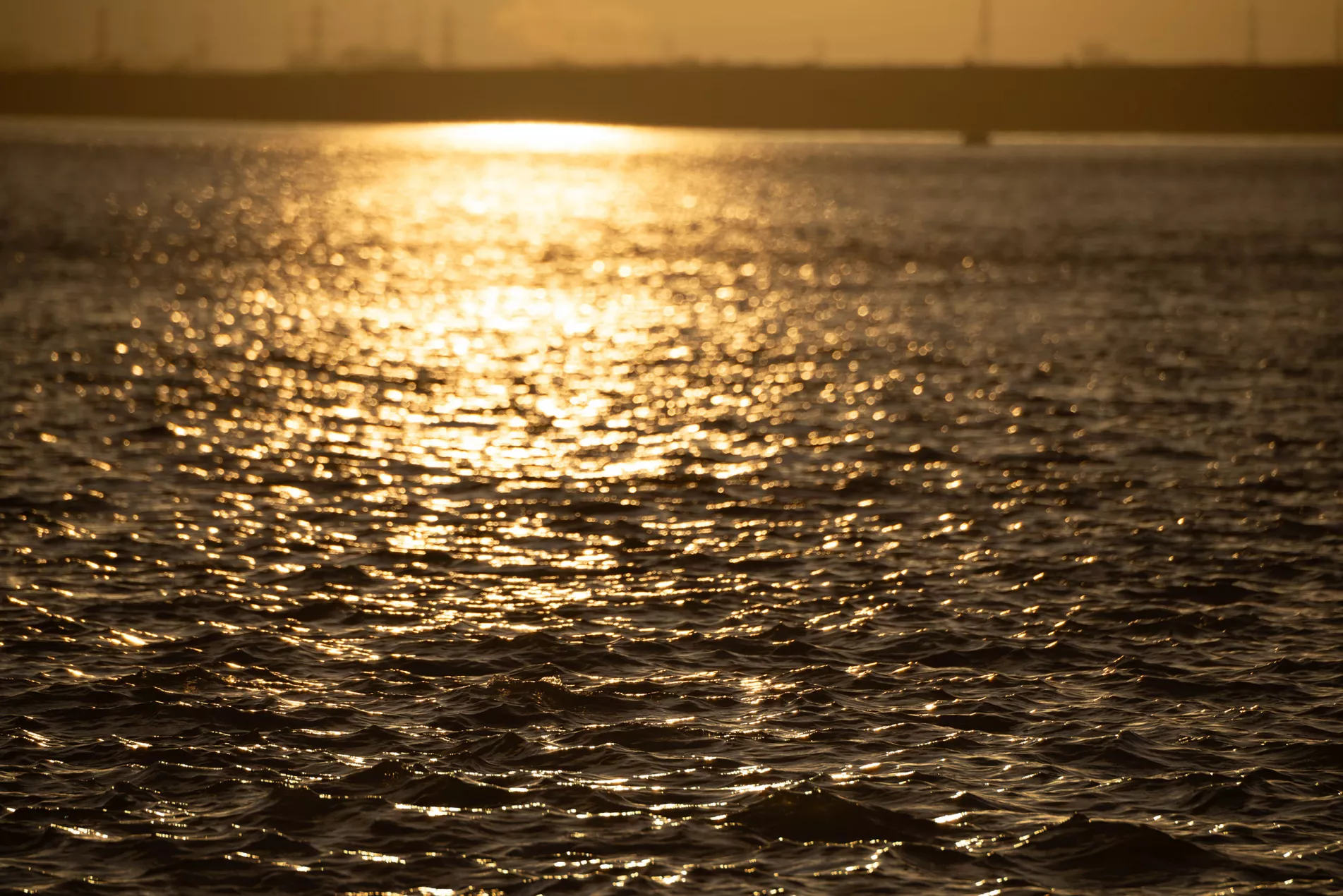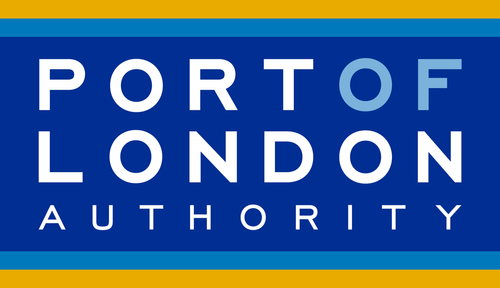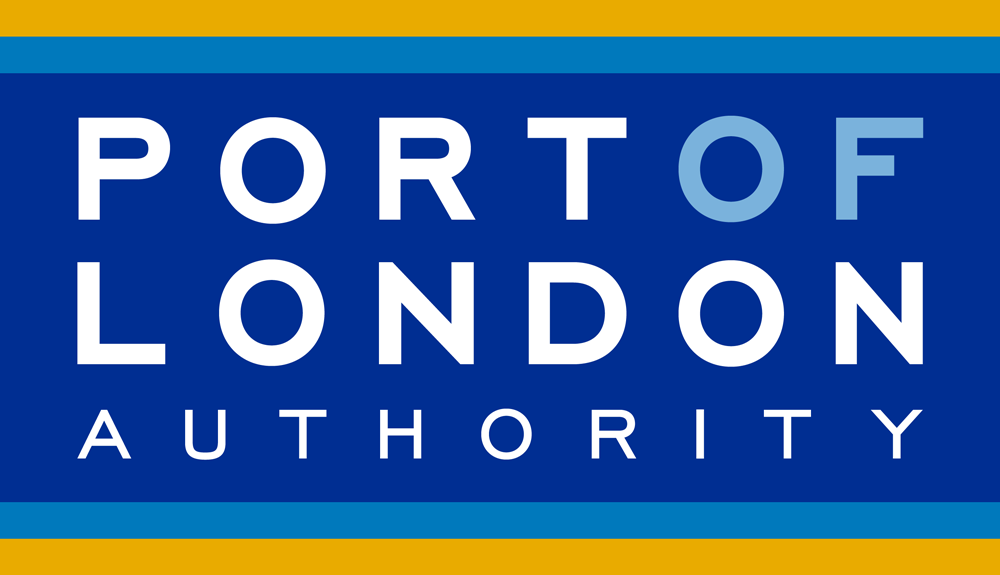Live Tides
NOTICES TO MARINERS
Charts & Surveys
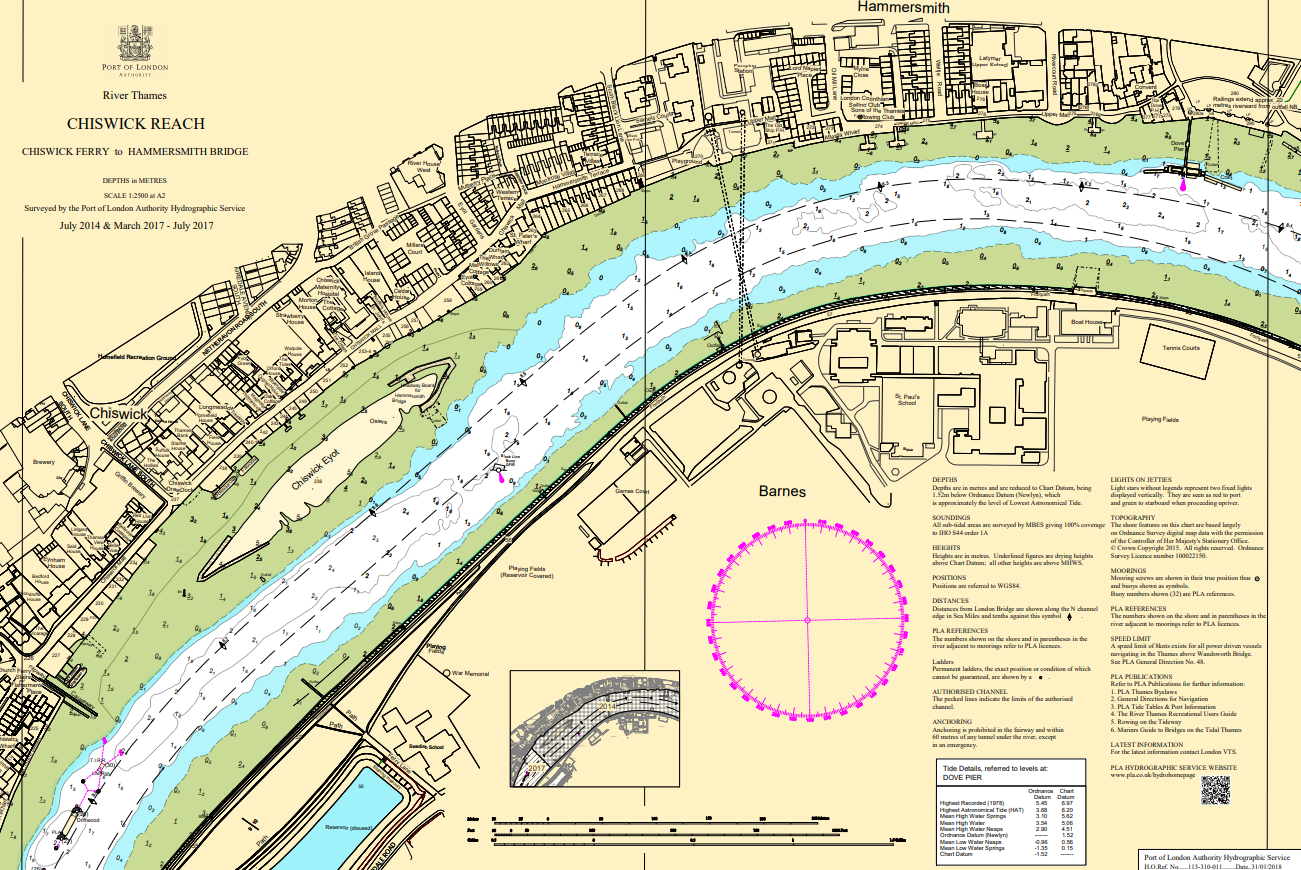
Incident reporting
Life-threatening emergencies on the river:
Call 999 and ask for the Coastguard
For near miss, safety observations and incident reporting click below
Tideway Code
A code of practice for rowing and paddling on the tidal Thames
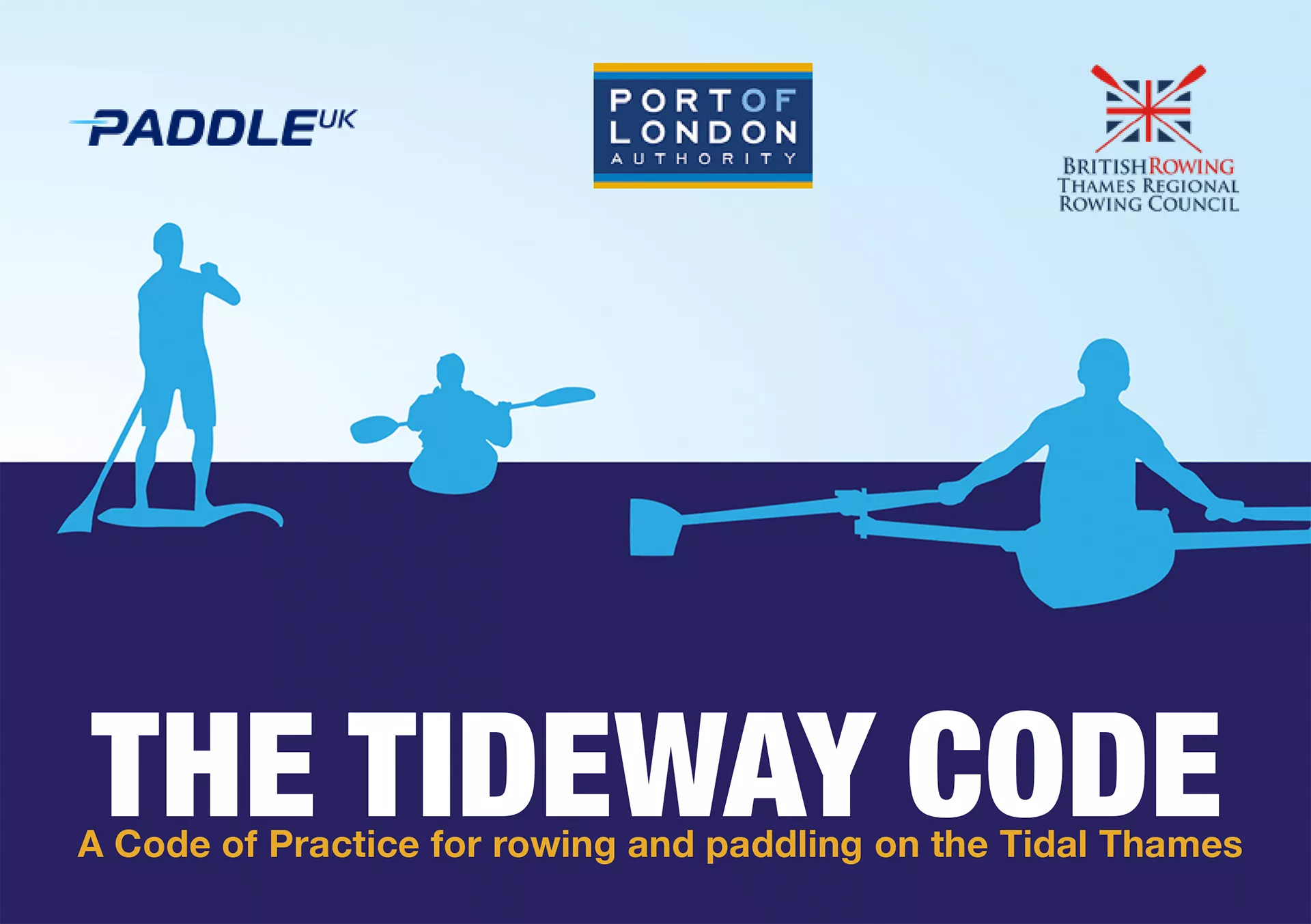
Safe Mooring of Vessels on the Thames 2016
Code of Practice
Management and Operation of Commercial Vessels on the Thames 2013
Code of Practice
Dangerous Substances in Bulk Byelaws 1991 (as amended)
Port of London Vessel Licensing Byelaws 2014
Port of London Thames Byelaws 2012
Navigate to a Byelaw
PART 1 - GENERAL
Byelaw 1: Citation and Commencement
Byelaw 2: Application of the Byelaws
Byelaw 3: Interpretation
Byelaw 4: Revocation of Byelaws
Byelaw 5: Offences
Byelaw 6: Defences to Proceedings
Byelaw 7: Application of Byelaws in certain circumstances
PART 2 - GENERAL DUTIES OF MASTERS OF VESSELS
Byelaw 8: Reporting Accidents and Incidents
Byelaw 9: Boat Races, Regattas, Processions and other River Events
PART 3 - GENERAL NAVIGATION AND SAFETY
Byelaw 10: Small, Fast Vessels
Byelaw 11: Navigation by Persons under the Age of 16
Byelaw 12: Thames AIS Carriage Requirements
Byelaw 13: Water-Skiing and other Similar Activities
Byelaw 14: Use of Personal Water Craft
Byelaw 15: Restrictions on Mooring
Byelaw 16: Speed Limits
Byelaw 17: Vessels Berthed or Moored
Byelaw 18: Anchors
Byelaw 19: Freeboard on Barges
Byelaw 20: Permission to Dive
Byelaw 21: Bathing and Swimming
Byelaw 22: Local Knowledge Requirements
PART 4 - STEERING AND SAILING BYELAWS
Byelaw 23: Obligation of the Master
Byelaw 24: Modifications to the International Collision Regulations
Byelaw 25: Vessels navigating against the tide and turning about
Byelaw 26: Vessels restricted in their ability to manoeuvre and underwater operations
Byelaw 27: Vessels navigating above Cherry Garden Pier and above Westminster Bridge
PART 5 - LIGHTS AND SHAPES
Byelaw 28: Obligation of the Master
Byelaw 29: Modifications to the International Collision Regulations
Byelaw 30: Additions to the International Collision Regulations
Byelaw 31: Hydrofoils and vessels exceeding a speed of 12 knots
Byelaw 32: Lights on vessels moored or berthed
Byelaw 33: Diving activity
Byelaw 34: Ferries
Byelaw 35: Barges
Byelaw 36: Bridges - Signals in arches or spans
PART 6 - SOUND SIGNALS
Byelaw 37: Obligation of the Master
Byelaw 38: Use of sound signals
Byelaw 39: Modifications to the International Collision Regulations
Byelaw 40: Additions to the International Collision Regulations
Byelaw 41: Warning signal in clear visibility
Byelaw 42: Vessels turning about
Byelaw 43: Vessels entering the fairway
PART 7 - RICHMOND LOCK
Byelaw 44: Obligation of Vessel Masters
Byelaw 45: General Prohibitions
PART 8 - MISCELLANEOUS
Byelaw 46: Machinery Noise
Byelaw 47: Damage to Vessels or Property
Byelaw 48: Protection of the foreshore
Byelaw 49: Discharge of sewage into the Thames
Byelaw 50: Dangers and obstructions to navigation
Byelaw 51: Requirement to maintain and survey and inspect operational berths
Byelaw 52: Marking of vessels operating as ferries
Byelaw 53: Vessel identification and marking
Byelaw 54: Disorderly behaviour
Byelaw 55: Advertisements
Byelaw 56: Seaplanes and flying boats
Byelaw 57: Wash and draw-off
The Port of London Authority in exercise of its powers under sections 162, 167 and 168 of the Port of London Act 1968 makes the following byelaws:
PART 1 - GENERAL
1. CITATION AND COMMENCEMENT
These byelaws may be cited as the Port of London Thames Byelaws 2012 and come into force on 1 July 2012.
2. APPLICATION OF THE BYELAWS
These byelaws do not apply in the Medway Approach Area, but unless otherwise stated, apply elsewhere in or (as the case may require) near the Thames.
3. INTERPRETATION
3.1 In these byelaws unless the context otherwise requires:
a) “AIS” means Automatic Identification System;b) “AIS A” means an AIS Class Alpha transponder system as required by IMO resolution MSC.74 (69) Annex 3;
c) “the Act” means the Port of London Act 1968;
d) “barge” includes dumb vessels, including but not limited to: barges, lighters, collar and mooring barges, crane barges and engineering
barges, pontoons, oil storage/processing barges and dredgers, but excludes any power-driven vessels;
e) “berthed” in relation to a vessel, means:
- i) secured to land or premises or to a landing stage extending above the level of mean high water springs or to a floating pier; or
- ii) made fast to another vessel so secured;
f) “commercial vessel” means any vessel which is not a pleasure vessel;
g) “dangerous substance” has the same meaning as in the Dangerous Substances in Harbour Areas Regulations 1987;
h) “designated anchorage” means an area designated by a harbourmaster as an anchorage area or berth and published on charts, in the PLA
Handbook of Tide Tables and Port Information or in Notices to Mariners;
i) “diving activity” means entering the water, and in order to survive such an environment, breathing air or other compressed gas at a pressure greater than atmospheric pressure, or using re-breather apparatus operating at ambient pressure, whether surface supplied or not (but does not include breath holding or snorkelling), and includes all diving, including the use of remote-controlled submersible devices and manned submersible craft, whether subject to the Diving at Work Regulations 1997 or not;
j) “dredge” means to cleanse, scour, cut, deepen, widen or take up or remove material from the bed or banks of the Thames;
k) “fairway” means a regular course or track of shipping, comprising all marked and/or charted navigable channels within the Thames and
includes the following areas:
- i) the Fisherman’s Gat;
- ii) the Princes Channel from the Tongue Sand Towers to the Oaze Precautionary Area;
- iii) the Black Deep and Knock John Channels from the seaward limit to the Oaze Precautionary Area;
- iv) the Barrow Deep and Mouse Channels from the seaward limit to the Warp;
- v) the East and West Swin Channels from the seaward limit to the Warp;
- vi) the Warp;
- vii) the Oaze Precautionary Area; and
- viii)the Thames to the west of Sea Reach No. 1 Buoy;
l) “Geographic Display Unit” means a unit which is compatible with Thames AIS, complying with the Thames AIS Technical Requirements
Specification;
m) “gross tonnage” in relation to a vessel means the tonnage as ascertained in accordance with the International Convention of Tonnage
Measurement of Ships 1969, or the Merchant Shipping (Tonnage) Regulations 1982, and where in accordance with those Regulations
alternative tonnages are assigned to a vessel, the gross tonnage of the vessel is, for the purposes of these byelaws, to be taken to be the larger of those tonnages;
n) “harbourmaster” means a person appointed by the PLA to be a harbourmaster and includes the deputies and assistants of a person so
appointed, and officers authorised to discharge the harbourmaster’s duties through one of the PLA’s VTS centres;
o) “High Speed Craft Code” means the International Code for the Safety of High-Speed Craft 2000, as adopted by IMO as Annex to Resolution
MSC.97(73) as amended by MSC.119(74) and from time to time;
p) “IALA” means International Association of Marine Aids to Navigation and Lighthouse Authorities;
q) “IMO” means the International Maritime Organisation;
r) “International Collision Regulations” means the International Regulations for Preventing Collisions at Sea 1972, as now given effect by the
Merchant Shipping (Distress Signals and Prevention of Collisions) Regulations 1996;
s) “length overall” means the maximum length of a vessel, including overhanging structure, cargo or equipment, and if a tug and tow, the
combination of the tug and the object(s) towed but not the length of the towing medium;
t) “LNG” means liquefied natural gas;
u) “LPG” means liquefied petroleum gas;
v) “lock foreman” means a person appointed by the PLA to be in charge of the operation of Richmond Lock;
w) “Lower Hope Point limit” means a line drawn across the Thames from latitude 51° 28.95' N longitude 000° 28.1' E (Lower Hope Point in the
county of Kent) in a direction 270° (T);
x) “Margaretness limit” means a line drawn across the river from the Margaretness light in a direction 334° (T);
y) “marine pollutants in bulk” means products carried as cargo which are subject to Annexes 1 and 2 of The International Convention for the
Prevention of Pollution from Ships 1973, as modified by the Protocol of 1978 relating to it, better known as MARPOL 1973 - 78, as amended from time to time. In the context of these byelaws "in bulk" means marine pollutant carried as cargo in tanks which are a structural part of, or
permanently attached to, the vessel. Residues of cargo remaining in cargo tanks following the complete discharge of the cargo are not included;
z) “master” in relation to a vessel, means any person having or taking the command, charge or management of a vessel, for the time being;
aa) “Medway Approach area” means an area bounded by a line drawn straight from the London Stone on the east side of Yantlet Creek on a
bearing 86° (T) until Warden Point in the Isle of Sheppey bears 166° (T), then on a bearing 166° (T) to the level of mean high water springs on the Kent bank of the Thames, then in a north-westerly direction along the level of mean high water springs to Garrison Point, then straight across the river Medway on a bearing 305° (T) to Dolly Bank and then in a northwesterly direction along the level of mean high water springs to the London Stone;
bb) “moored” in relation to a vessel, means:
- i) made fast ahead or astern, or both, at a mooring chain or buoy;
- ii) made fast both ahead and astern by anchors; or
- iii) secured alongside another vessel so made fast;
cc) “navigation” means the movement on or in the water for whatever purpose of any vessel, whether travelling between two locations or not,
but does not include any vessel under tow;
dd) “No Anchoring Area” means an area adjacent to the Thames Barrier in which anchoring is prohibited by general direction of the PLA;
ee) “Notices to Mariners” means notices published by the harbourmaster providing information and advice to mariners and river users;
ff) “not under command” has the same meaning as in the International Collision Regulations;
gg) “occasionally” means where a vessel is navigated, worked or moored within an area of the Thames not more than three times in any 12 month period, and on each such occasion, is navigated, worked or moored within that area for no more than 48 hours;
hh) “operational berth” means any location in the Thames where the owner routinely moors commercial vessels or in the future, intends to moor commercial vessels;
ii) “permit to dive” means written permission from the harbourmaster, allowing a person or persons to undertake diving activity in the Thames;
jj) “person” includes a body corporate;
kk) “personal water craft” means a small craft, propelled by a directionally controlled water jet or other mechanical means of propulsion and steered either:
- i) by means of a handlebar operated linkage system (with or without a rudder at the stern);
- ii) by the person or persons riding the craft using their body weight for the purpose; or
- iii) by a combination of the methods referred to respectively in i) and ii) above.
ll) “PLA” means Port of London Authority;
mm) “pleasure vessel” means:
- a) any vessel which at the time it is being used is:
- i) in the case of a vessel wholly owned, or bareboat chartered or hired by an individual or individuals, used only for the sport or pleasure of the owner, charterer or hirer or the immediate family or friends of the owner, charterer or hirer; or
- ii) in the case of a vessel owned, or bareboat chartered or hired by a body corporate, used only for sport or pleasure and on which the
persons are employees or officers of the body corporate, or their immediate family or friends; and is on a voyage or excursion, which is one for which the owner, charterer or hirer does not receive money for or in connection with operating the vessel or carrying any person, other than as a contribution to the direct expenses of the operation of the vessel incurred during the voyage or excursion and in the case of a vessel
bareboat chartered or hired, the charter or hire fee payable by the charterer or hirer; or
- b) any vessel wholly owned, or bareboat chartered or hired by or on behalf of a members' club formed for the purpose of sport or pleasure
which, at the time it is being used, is used only for the sport or pleasure of members of the club or their immediate family; and for the use of which any charges levied (other than, in the case of a vessel bareboat chartered or hired, the charter or hire fee payable by the
charterer or hirer) are paid into club funds and applied for the general use of the club and/or upkeep of the vessel; and in the case of any vessel referred to in paragraph (a) or (b) above no other payments are made by or on behalf of the users of the vessel, other than by the owner, charterer or hirer and in this definition "immediate family" means, in relation to an individual, the husband, wife or partner of the individual, and a relative of the individual or the relative's husband or wife, and "relative" means brother, sister, ancestor or lineal descendant;
Note: The definition of pleasure vessel follows closely that used in the Merchant Shipping (Survey and Certification) Regulations 2005.
nn) “prolonged blast” has the same meaning as in the International Collision Regulations;
oo) “POB” means persons on board;
pp) “reporting vessel” means every vessel which is required by the PLA’s General Directions to report its position, intentions or movements,
specifically:
- i) vessels of more than 40 metres in length overall,
- ii) vessels of gross tonnage of more than 50 tons which ordinarily also navigate outside the Thames,
- iii) tugs engaged in towing, or about to tow one or more vessels;
qq) “restricted visibility” means all circumstances when visibility is less than 0.5 nautical miles;
Note: Within the Thames a harbourmaster or his authorised representative may, using all available information, decide that restricted visibility prevails in a particular area or at a particular time or is likely to prevail and inform shipping as appropriate.
rr)“short blast” has the same meaning as in the International Collision Regulations;
ss)“specified vessel” means any vessel having on board (including in its slop tanks), quantities of the following (IMO codings in brackets):
- i) explosives (Class 1, excluding Class 1.4), in excess of 10 kg Net Explosive Quantity;
- ii) LNG in bulk, LPG in bulk or being non-gas free following discharge of these cargoes (Class 2);
- iii) flammable liquids and substances in bulk or being non-gas free following discharge of these cargoes (Class 3 of flashpoint <23° C);
and/or - iv) toxic and corrosive substances in bulk or being non-gas free following discharge of these cargoes (Classes 6.1 and 8.0);
tt) “tank barge” means any barge designed and used for the transportation of vegetable, animal or mineral oils in bulk;
uu) “Thames” means so much of the river Thames, the Thames Estuary, rivers, streams, creeks, watercourses and the sea as is within the port
limits described in paragraph 2 of Schedule 1 to the Act;
vv) “Thames AIS” means an AIS Class Alpha derivative incorporating a Geographic Display Unit complying with the Thames AIS Technical
Requirements Specification;
ww) “Thames AIS Technical Requirements Specification” means the PLA publication containing the minimum requirements and settings for
equipment forming Thames AIS available from the PLA and published on its website and as updated from time to time as notified in advance by a Notice to Mariners;
xx) “VTS Centre” means the Vessel Traffic Service Centres at Gravesend (Port Control Centre) and Woolwich (Thames Barrier Navigation Centre) - Call Signs ‘London VTS’ and includes any other VTS control point through which a harbourmaster’s instructions and advice are issued to masters of vessels by VHF radio and to which vessels report.
3.2 In these byelaws, unless the context otherwise requires:
a) words and expressions used in these byelaws not defined above have the same meanings as in the Act;
b) the byelaw headings do not form part of or affect the construction and interpretation of the byelaws;
c) words importing the singular are to be construed as importing the plural and vice versa.
Note: The notes in these Byelaws are for information only; they form no part of the Byelaws and do not have any legal effect.
3.3 For the purposes of these byelaws and for byelaw 9 of the Port of London River Byelaws 1978, the person in charge and having control of a personal water craft is the master, and the use of personal water craft is deemed to be navigation.
4. REVOCATION OF BYELAWS
Except for byelaw 9, the Port of London River Byelaws 1978 (as amended) are revoked.
5. OFFENCES
A person who breaches these byelaws is guilty of an offence and is liable, on conviction before a court of summary jurisdiction, to a fine not exceeding level 5 on the standard scale.
6. DEFENCES TO PROCEEDINGS
6.1 In any proceedings for a breach of these byelaws it is a defence for the person charged to prove:
a) that all reasonable precautions were taken and all due diligence exercised to avoid the commission of such an offence; or
b) that there is a reasonable excuse for the act or failure to act.
6.2 If in any case the defence provided by byelaw 6.1(a) involves the allegation that the commission of the offence was due to the act or default of another person, the person charged is not, without leave of the court, entitled to rely on that defence unless, within a period ending seven clear days before the hearing, the person charged has served on the prosecutor a notice in writing giving such information identifying or assisting in the identification of that other person as then in the possession of the person charged.
7. APPLICATION OF BYELAWS IN CERTAIN CIRCUMSTANCES
7.1 Where a person breaches these byelaws but that breach is due to the act or default of some other person, that other person is guilty of an offence; and that other person may be charged with, and convicted of, the offence by virtue of this byelaw whether or not proceedings for the offence are taken against any other person.
7.2 Where a breach of these byelaws which is committed by a body corporate is proved to have been committed with the consent or connivance of, or to be attributable to any neglect on the part of, a director, manager, secretary or other similar officer of the body corporate, or any person who was purporting to act in any such capacity, that person, as well as the body corporate, is guilty of that offence and is liable to be proceeded against in accordance with byelaw 5.
PART 2 - GENERAL DUTIES OF MASTERS OF VESSELS
8. REPORTING ACCIDENTS AND INCIDENTS
8.1 Where any vessel has, whilst in the Thames:
a) sunk or is in danger of sinking;
b) been abandoned;
c) become derelict;
d) been in collision with another vessel, shore facility, the river embankment, a structure including any part of a bridge or a berthed or moored vessel or object;
e) been damaged or caused damage to anything (including a vessel);
f) been or is on fire or has suffered an explosion;
g) taken the ground or stranded (not being a vessel which has intentionally taken the ground);
h) run into, fouled or damaged any light, buoy, beacon or other aid to navigation;
i) suffered any person falling overboard except in relation to a recoverable capsize of a sailing dinghy or a vessel propelled by paddles or oars; or
j) suffered any other accident normally required to be reported to the Marine Accident Investigation Branch or the Maritime & Coastguard Agency, or both.
or where a commercial vessel has, whilst in the Thames:
k) lost mechanical propulsion, steering or power or experienced any other serious mechanical defect whilst underway;
l) lost deck cargo over the side or had cargo shift so as to endanger the vessel or affect its navigation;
m) been or is carrying a dangerous substance, and any spillage or loss of containment has occurred,
n) lost, slipped or parted from an anchor, or where the anchor of the vessel has fouled another anchor or cable or other obstruction;
o) lost or parted one or more mooring lines whilst berthed or moored; a verbal report must immediately be made by the vessel master, either
directly or through the appropriate VTS Centre, to the harbourmaster regarding the occurrence. The report must include the name and the
position of the vessel and the nature of the incident, and such further information, where known, as the harbourmaster may reasonably request.
8.2 A written report must be submitted by the vessel master to the harbourmaster, as soon as practicable after the submission of the verbal
report, required by byelaw 8.1 above. The written report must give the full details of the occurrence, in a form prescribed by the harbourmaster.
9. BOAT RACES, REGATTAS, PROCESSIONS AND OTHER RIVER EVENTS
9.1 A person must not organise or promote a boat race, regatta, stunt, procession, exhibition, firework display, air race or other river event on or
over the Thames except with the consent of the harbourmaster.
9.2 Any person who proposes to organise or promote a boat race, regatta, stunt, procession, exhibition, firework display, air race or other river event on or over the Thames, must consult with the harbourmaster on the navigational and safety issues arising from the proposed event and give the harbourmaster at least four weeks notice of the proposed event.
9.3 Every person navigating a vessel in or in connection with such an event must comply with the instructions of a harbourmaster relating to it.
9.4 Any person who proposes to organise or promote a boat race, regatta, stunt, procession, exhibition, firework display, air race or other river event, must provide to the harbourmaster the findings of any comprehensive risk assessment requested as a result of the consultation under byelaw 9.2 in respect of the event in question. The risk assessment must identify the relevant hazards and any suitable procedures, precautions and other risk control measures to be implemented to ensure any risk to persons or navigational safety or both is mitigated and maintained as low as reasonably practicable.
9.5 In this byelaw, “air race” means any air race which uses the river as a course or part of a course.
Note:
- Provided they comply with the minimum timescale set out in byelaw 9.2, local sailing, rowing and other marine activity clubs may submit event information to the district harbourmaster in advance on a 6-monthly or annual basis. Such information should include a programme of planned events and proposed regular club activities, such as informal races or training. Both planned events and regular club activities are to be supported by an appropriate generic risk assessment.
- Subject to the generic risk assessment meeting the requirements in this byelaw, the district harbourmaster will approve club events and activities programmes in advance, for the period in question.
- However, any unscheduled event or activity which has not been submitted and approved under a general club events and activities programme should be discussed with the district harbourmaster within the timescales required by Byelaw 9.2; and if the harbourmaster decides that they fall outside the scope of the club’s generic risk assessment, they will be subject to the specific risk assessment requirements of Byelaw 9.4.
PART 3- GENERAL NAVIGATION AND SAFETY
10. SMALL, FAST VESSELS
10.1 The master of a vessel underway, which is less than 13.7 metres in length overall and capable of exceeding a speed of 12 knots through, on or over the water must be in a position:
a) to exercise proper control of the vessel and
b) to use the dedicated engine cut-out system, if fitted.
10.2 The requirements of byelaw 10.1 do not apply where the vessel is being used for search and rescue, fire brigade, ambulance, law enforcement, public safety, security or police purposes or for purposes of the harbourmaster, if the observance of this byelaw would be likely to hinder the use of the vessel for those purposes for which it is being used on that occasion.
Note: The arrangements referred to in byelaw 10.1 b) above is commonly known as a ‘kill cord’ system.
11. NAVIGATION BY PERSONS UNDER THE AGE OF 16
11.1 Except for the purposes of an organised event subject to the requirements of byelaw 9 or with the harbourmaster’s consent, a person under the age of 16 years must not be the master of a power-driven vessel which is capable of exceeding a speed of 8 knots in still water or which, whether so capable or not, is propelled by an engine producing more than 7.5Kw or rated by the manufacturer of the engine as capable of producing more than 7.5Kw.
11.2 A person under the age of 16 years not allowed to be master, may operate such a power-driven vessel as is referred to in byelaw 11.1, but must be under the direct supervision of the vessel’s master at all times when the vessel is underway.
12. THAMES AIS CARRIAGE REQUIREMENTS
12.1 It is the duty of a master to comply with the requirements of this byelaw.
12.2 Except for tugs falling within the provisions of byelaw 12.6 below, the following power-driven vessels, when navigating or working in the Thames between Richmond Lock and the Margaretness limit, must carry and operate Thames AIS or AIS A:
a) vessels of more than 40m in length overall;
b) vessels having a gross tonnage of more than 50 tons (other than pleasure vessels having a gross tonnage of more than 50 tons, but which are under 40m in length overall);
c) tugs engaged in towing or pushing, or about to tow or push one or more vessels;
d) specified vessels or vessels carrying marine pollutants in bulk; and
e) vessels holding a valid certificate of compliance under the provisions of byelaw 16.3.
12.3 In addition, Class IV, V and Class VI passenger vessels navigating or working in the Thames between Richmond Lock and the Denton Limit must:
a) carry and operate Thames AIS or AIS A;
b) carry an electronic POB reporting system which meets the minimum
standards for Thames AIS, specified by the PLA in the Thames AIS Technical Requirements Specification; and
c) operate such POB reporting system in accordance with the procedures specified by the PLA in Procedures for the Operation of Thames AIS and Persons On Board Reporting System.
Associated guidance: Thames AIS Revised Specification
12.4 Except for tugs described in byelaw 12.5 below all vessels, which fall within byelaw 12.2 or 12.3 above, must carry and operate a Geographic Display Unit when navigating or working above London Bridge.
12.5 Tugs which fall within byelaw 12.2 c) above are exempt from carrying an onboard Geographic Display Unit if they are less than 40m in length overall, or less than 50 gross tons.
12.6 Tugs which fall within byelaw 12.2 c) above are exempt from complying with the requirements of byelaw 12.2 above if they are undertaking towage or pushing within a radius of 0.5 nautical miles of their permanent place of business.
Note: For the purposes of byelaw 12.3, the PLA’s Thames AIS Technical Requirements Specification and Procedures for the Operation of Thames AIS and Person On Board Reporting System are published separately by the PLA, and provided to operators whose vessels are subject to carriage requirements under this byelaw prior to procurement and fitting. The documents are also published on the PLA website.
13. WATER-SKIING AND OTHER SIMILAR ACTIVITIES
13.1 A person must not engage or take part in water-skiing, aqua-planing, paddle boarding, swimming with a board, kite-surfing, wake-boarding, parakiting, or any similar activity within:
a) a fairway or a designated anchorage; or
b) 200 metres of a wharf, jetty, pier, berth, terminal, public beach, bathing place or residential property except in an area authorised for that purpose by the PLA.
13.2 The master of a vessel towing a person or persons water-skiing, parakiting or undertaking similar towed activity, must ensure that there is on board:
a) for each person being towed, a rescue quoit with line or other sufficient hand thrown rescue device;
b) two hand-held distress signals and a fire extinguisher; and
c) at least one other person able to take charge of the vessel and to give such assistance as may reasonably be required during the towing.
14. USE OF PERSONAL WATER CRAFT
14.1 For the purpose of these byelaws, the use of personal water craft in the Thames is subject to the International Collision Regulations, except that the requirements of Rules 23(c) (ii) and 33 of the International Collision Regulations do not apply to personal water craft.
14.2 Subject to byelaw 14.3, a person must not launch or recover a personal water craft onto or from the Thames except with the permission of the harbourmaster (which permission may be given specifically or in respect of all personal water craft in a specified location).
Associated guidance: Personal Watercraft in the Thames Estuary Code of Conduct
14.3 In an emergency a person may recover a personal water craft from any area of the Thames.
14.4 A person using a personal water craft must not enter a fairway except where crossing in accordance with Rule 9 of the International Collision Regulations.
14.5 A personal water craft must not be used within 200 metres of a wharf, jetty, pier, berth, terminal, public beach, bathing place or residential property except in an area authorised for that purpose by the PLA.
14.6 A person must not operate or use a personal water craft on the Thames upstream of the Margaretness limit.
14.7 Any person using a personal water craft on the Thames between the Lower Hope Point limit and the Margaretness limit must provide their name and address and details of the vessel to the harbourmaster on or before 1 July 2012 or on first using the vessel on this part of the Thames after that date.
14.8 For the purpose of these byelaws, a personal water craft is in use when it is planing or proceeding at a speed of more than eight knots or both.
14.9 This byelaw does not apply where a personal water craft is being used for search and rescue, fire brigade, ambulance, law enforcement, public or recreational safety, security or police purposes or for training for such purposes or for the purposes of the harbourmaster, downstream of the Margaretness limit.
Note: For the purposes of byelaw 14.2, the specified locations for which the harbourmaster has given general permission are set out in the PLA publication Personal Watercraft in the Thames Estuary Code of Conduct.
15. RESTRICTIONS ON MOORING
The master of a vessel must not, without the permission of the harbourmaster, cause or permit the vessel:
a) to be berthed or moored at any docks, landing places, other works and land at any time vested in, belonging to or administered by the PLA; or
b) to obstruct or interfere with the access to a dock entrance.
16. SPEED LIMITS
16.1 The master of a power-driven vessel navigating in a part of the Thames to which this byelaw applies must ensure that it does not exceed a speed of 8 knots through, on or over the water, provided that this byelaw does not apply:
a) where the vessel is being used for search and rescue, fire brigade, ambulance, law enforcement, public or recreational safety, security or police purposes or for training for such purposes or for the purposes of the harbourmaster, if the observance of this byelaw would be likely to
hinder that use of the vessel; or
b) where a vessel, having for the purpose of this byelaw been approved by a harbourmaster as one which may exceed a speed of 8 knots through the water, is engaged in escorting a rowing boat in training;
c) where the vessel is being used in connection with any activity involving the use of personal water craft, waterskiing, parakiting or aquaplaning in an area authorised by the PLA or;
d) where the vessel has been approved by the harbourmaster to exceed a speed of 8 knots through the water, in connection with a river event that is subject to the requirements of byelaw 9, and if it does so in accordance with such approval.
16.2 The parts of the Thames to which byelaw 16.1 applies are:
a) the Thames above Wandsworth Bridge;
b) Deptford Creek;
c) the River Lee or Bow Creek;
d) Barking Creek;
e) Dartford Creek;
f) the creeks to the north and west of Canvey Island and of the island known as Leigh Marsh or Two Tree Island, which are:
i) Holehaven, Vange and Pitsea creeks north of line drawn from Holehaven Point on a bearing 270°T; and
ii) Leigh Creek, Hadleigh Ray, Benfleet and East Haven Creeks west of a line drawn from Canvey Point on a bearing 000°T to the Leigh-on-Sea shore; and
g) Yantlet Creek.
16.3 The master of a power-driven vessel navigating between Wandsworth Bridge and Margaretness limit must ensure that it does not exceed a speed of 12 knots through, on or over the water, provided that this byelaw does not apply:
a) if the vessel falls within the exceptions described in byelaw 16.1 a), or
b) where a vessel, having for the purpose of this byelaw been approved by the harbourmaster as one which may exceed a speed of 12 knots
through the water, is engaged in:
- i) escorting a rowing boat in training;
- ii) escorting a boat race or regatta; or
c) where the vessel has been approved by the harbourmaster to exceed a speed of 12 knots through the water, in connection with a river event that is subject to the requirements of byelaw 9, and if it does so in accordance with such approval.
d) where the harbourmaster has issued a certificate of compliance, which allows the vessel, subject to continued compliance with the International Collision Regulations (as modified by these byelaws), to navigate up to but not exceeding a speed of:
- i) 25 knots through, on or over the water in the area of the Thames between Wandsworth Bridge and Lambeth Bridge, and
ii) 30 knots through, on or over the water in the area of the Thames between St Saviour’s Dock and the Margaretness limit.
16.4 The master of a power-driven vessel operating under a valid certificate of compliance referred to in byelaw 16.3d) ii), must ensure that it does not exceed a speed of 15 knots through, on or over the water when navigating through the Thames Barrier in the designated No Anchoring Area, provided that this byelaw does not apply if the vessel falls within the exceptions described in byelaw 16.1 a).
Note: 1. A certificate of compliance will only be issued when a vessel operator can demonstrate compliance with the relevant provisions of the High Speed Craft Code and the Small Commercial Vessel Code together with the International Safety Management Code, and the carriage and use of AIS.
2. Further details of the requirements to be met for the issue of a certificate of compliance can be obtained from the district harbourmaster.
3. If, as a result of compliance with a mandatory speed limit, a planing vessel produces unacceptable wash at 12 knots, the master should reduce speed further to ensure that the vessel produces safe levels of wash.
4. A certificate of compliance for the purposes of this byelaw is not to be taken as compliance for the purposes of any other requirement in PLA byelaws, general directions or provisions in the Act.
Associated guidance: Technical Requirements for the issue of a Certificate of Compliance
17. VESSELS BERTHED OR MOORED
17.1 The master of a vessel must ensure when the vessel is berthed or moored that:
a) it is securely made fast;
b) her moorings are adjusted from time to time to allow for the rise and fall of the tide and for the loading and discharge of cargo and to provide for the safety of persons lawfully embarking and disembarking; and
c) her engines are not worked so as to cause, or be likely to cause injury to any person, including crew, passengers or persons ashore, damage to
moorings, the bed or banks of the Thames, or other property.
Note: Where a vessel is moored at a tier, it is most important that her moorings are kept taut. If they are not, the effect of wind or tide or the wash or draw-off of passing vessels may result in parted moorings. Failure to keep them taut may also result in the vessels taking the
ground on the inshore side of the tier.
17.2 The master of a vessel must ensure when the vessel is berthed that:
a) it is laid as close as possible alongside the land, premises, landing stage, floating pier or other vessel at which it is berthed, and;
b) neither the vessel nor her moorings obstruct other vessels, nor hamper the use of any dock entrance, pier, wharf, or jetty.
17.3 The master of a vessel must ensure when the vessel is moored at a tier that her anchors do not lie on the river-bed outside the line of the tier.
Note: The object of byelaw 17.3 is to prevent a vessel which uses an anchor for manoeuvring from being fouled by the anchor of a vessel at a tier.
18. ANCHORS
The master of a vessel must ensure that the vessel is equipped with one or more suitable anchors with chain, cable or rope, and that these are at all times available for immediate use, provided that this byelaw does not apply where the vessel is a barge, sailing dinghy, personal water craft or a vessel under oars.
19. FREEBOARD ON BARGES
19.1 This byelaw does not apply to a barge while being loaded or discharged or to a self-propelled tank barge at any time.
19.2 A person must not cause or permit:
a) the top of the gunwale of a barge without coamings to be anywhere less than 0.35 metres above the water;
b) the top of the coamings of an undecked or unhatched barge to be anywhere less than 0.35 metres above the water, or the top of the
gunwale to be anywhere less than 0.15 metres above the water;
c) the top of the coamings of a hatched or decked barge to be anywhere less than 0.35 metres above the water, or the top of the gunwale to be
anywhere less than 0.075 metres above the water; or
d) a barge to be loaded so that the vessel’s assigned freeboard mark is submerged
20. PERMISSION TO DIVE
20.1 A person must not undertake any diving activity in the Thames, without first obtaining the permission of the harbourmaster.
20.2 Any person intending to undertake any diving activity in the Thames must inform the harbourmaster, through the appropriate VTS Centre, prior to the commencement, and on the completion, of any diving activity.
Note: Details of the requirements and procedure for obtaining a permit to dive for any diving activity are published in PLA Notices to Mariners.
21. BATHING AND SWIMMING
21.1 A person must not without the prior permission of the PLA, given in writing, and in accordance with such conditions as the PLA may attach to any such permission:
a) swim (with or without a flotation device) in the Thames anywhere between Crossness and Putney Bridge, or;
b) bathe or swim in any fairway or designated anchorage, or where a notice is displayed by the PLA prohibiting bathing or swimming.
21.2 This byelaw does not apply to persons:
a) undertaking diving activity;
b) engaged in the emergency repair or inspection of vessels or structures; or
c) bathing or swimming in the Southend Foreshore Exemption Areas or the Sheerness Exemption Area described in paragraph 1 of the second
column of Schedule 8 to the Act.
Note: The Exemption Areas are shown indicatively on the plans in Appendix III of these byelaws.
22. LOCAL KNOWLEDGE REQUIREMENTS
22.1 The master of any vessel which is:
a) less than 40 metres but greater than 13.7 metres in length overall, and not subject to compulsory pilotage; or
b) less than 13.7 metres in length overall engaged in towing or carrying passengers; and
c) not a pleasure vessel if navigating and/or working in the Thames local knowledge area, is required to hold a valid Boatmaster’s Licence Thames Local Knowledge Endorsement; or alternatively, to demonstrate such local knowledge to an equivalent standard, through assessment by the PLA.
22.2 This byelaw does not apply in emergency situations or to persons holding a valid sailing barge masters qualification issued by the Sailing Barge Masters Qualification Board.
22.3 In this byelaw “Thames local knowledge area” means the extent of waters described in column (2) of the table in paragraph 6 of Part 3 of Schedule 3 to the Merchant Shipping (Inland Waterway and Limited Coastal Operations) (Boatmasters’ Qualifications and Hours of Work) Regulations 2006 (SI 2006/3223) where the port or harbour area entry in column (1) of that table reads “Port of London”.
Note: The harbourmaster will provide details of the PLA Local Knowledge Assessment criteria and procedures upon request.
PART 4 - STEERING AND SAILING BYELAWS
23. OBLIGATION OF THE MASTER
It is the duty of the master of a vessel to comply with the requirements of this Part of these byelaws.
24. MODIFICATIONS TO THE INTERNATIONAL COLLISION REGULATIONS
Notwithstanding Part C of the International Collision Regulations and Annex I:
a) a vessel must not cross or enter a fairway so as to obstruct another vessel proceeding along the fairway;
b) when a power-driven vessel operating as a ferry is crossing the fairway, it must keep out of the way of a vessel proceeding along the fairway;
c) a power-driven vessel must not proceed abreast of another power-driven vessel except for the purposes of overtaking that other vessel; and
d) a vessel in a fairway above Tilburyness must not overtake a vessel which is itself overtaking another vessel
e) all vessels must, in determining a safe speed, have regard to:
- i) the safety of other river users, passengers and crew,
- ii) tidal flow, and
- iii) the navigational environment including port infrastructure.
Note: The steering and sailing rules in byelaw 24 are inconsistent with the provisions of the International Collision Regulations but apply as special rules by virtue of rule 1(b) as applied by the Merchant Shipping (Distress Signals and Prevention of Collisions) Regulation 1996. It is the duty of the master of a vessel to comply with the requirements of the International Collision Regulations except as provided for in Byelaw 24.
25. VESSELS NAVIGATING AGAINST THE TIDE AND TURNING ABOUT
25.1 A power-driven vessel or a vessel under oars navigating against the tide must, when approaching or passing under a bridge, or when approaching or rounding a bend in the Thames, navigate with caution and prepare to stop to avoid risk of collision with another vessel that is navigating with the tide.
25.2 A power-driven vessel or a vessel under oars intending to turn about must, before commencing to do so, ensure that the fairway is sufficiently clear for the manoeuvre so as not to endanger or not to impede any other vessel.
26. VESSELS RESTRICTED IN THEIR ABILITY TO MANOEUVRE AND UNDERWATER OPERATIONS
Where a vessel is exhibiting the lights or shapes prescribed in paragraph (d) or (e) of Rule 27 of the International Collision Regulations, a vessel
approaching or passing that vessel must proceed slowly and with caution.
27. VESSELS NAVIGATING ABOVE CHERRY GARDEN PIER AND ABOVE WESTMINSTER BRIDGE
27.1 A vessel of less than 40 metres in length navigating above Cherry Garden Pier, and a sailing vessel navigating above Cherry Garden Pier must not impede the passage of:
a) a vessel of 40 metres or more in length; or
b) a vessel engaged in towing.
27.2 In addition to their obligations under byelaw 27.1 above, a vessel of less than 20 metres in length navigating above Westminster Bridge and a sailing vessel navigating above Westminster Bridge must not impede the passage of a vessel of 20 metres or more in length.
27.3 Notwithstanding that a vessel has priority under byelaw 27.1 or 27.2 above, it must, when navigating against the tide, comply with byelaw 25.1 above.
PART 5 - LIGHTS AND SHAPES
28. OBLIGATION OF THE MASTER
It is the duty of the master of a vessel to comply with the requirements of this Part of these byelaws unless otherwise stated.
29. MODIFICATIONS TO THE INTERNATIONAL COLLISION REGULATIONS
Notwithstanding Part C of and Annex 1 of the International Collision Regulations:
a) on a power-driven vessel of 20 metres but less than 50 metres in length, the forward masthead light, or if only one masthead light is carried then that light, need not be placed at a greater height above the hull than 3.5 metres;
b) on a power-driven vessel that ordinarily navigates both above and below London Bridge the masthead light or lights may, when the vessel is
navigating above Cherry Garden Pier, be placed at any convenient height above the hull.
c) Rules 24(e), (f), (g) and (h) and 27 of the International Collision Regulations do not apply to a barge; and
d) Rule 30(d) of the International Collision Regulations does not apply to a barge, to a berthed vessel, or to any vessel above Cherry Garden Pier.
Note: The lights and shapes rules in byelaw 29 are inconsistent with the provisions of the International Collision Regulations but apply as special rules by virtue of rule 1(b) as applied by the Merchant Shipping (Distress Signals and Prevention of Collisions) Regulation 1996.
30. ADDITIONS TO THE INTERNATIONAL COLLISION REGULATIONS
30.1 The lights and shapes required by the byelaws 31 to 35 are additional to the lights and shapes required by the International Collision Regulations as modified by byelaws 28 and 29.
30.2 The lights required by byelaws 34 and 35 below must have an intensity as specified in Section 8 of Annex I to the International Collision Regulations so as to be visible at the minimum ranges of miles specified in those byelaws.
31. HYDROFOILS AND VESSELS EXCEEDING A SPEED OF 12 KNOTS
31.1 Rule 23(b) of the International Collision Regulations (which requires an allround flashing yellow light to be exhibited in addition to the lights prescribed in Rule 23(a), applies to:
a) a hydrofoil vessel underway;
b) any non-emergency service or non-regulatory vessel to which byelaw 16.3(a) applies, while that vessel exceeds a speed of 12 knots when
navigating above the Margaretness limit;
c) any vessel to which byelaw 16.3(d) applies, while that vessel exceeds a speed of 12 knots when navigating above the Margaretness limit; and in
d) an air-cushion vessel operating in the non-displacement mode.
31.2 All vessels subject to the requirements of byelaw 31.1 must exhibit an allround flashing yellow light by day and by night (as required by byelaw 31.1 and by Rule 23(b) of the International Collision Regulations).
31.3 In this byelaw “all-round flashing yellow light” means a yellow light flashing at regular intervals at a frequency of 120 flashes or more per minute over an arc of the horizon of 360 degrees.
32. LIGHTS ON VESSELS MOORED OR BERTHED
32.1 Subject to the following paragraph, a moored vessel which is not:
a) a barge,
b) permanently moored fore and aft close to the bank of the Thames, or
c) less than 20 metres in length must exhibit the lights or shapes required by Rule 30 of the International Collision Regulations to be exhibited by a vessel at anchor.
32.2 If the harbourmaster so directs:
a) a moored vessel of less than 20 metres in length and a berthed vessel must exhibit by night the lights required by Rule 30 of the International
Collision Regulations to be exhibited by a vessel at anchor, and
b) a moored barge must exhibit the lights or shapes required by Rule 30 of the International Collision Regulations to be exhibited by a vessel at anchor.
33. DIVING ACTIVITY
In addition to the signals required by Rule 27(d) or (e) of the International Collision Regulations, a vessel supporting any diving activity permitted by the harbourmaster under byelaw 20 must:
a) by night, exhibit conspicuously an illuminated rigid replica of the International Code Flag “A’ not less than 1 metre in height; and
b) by day, exhibit conspicuously a red flag not less than 1 metre square in a position as close as possible to the diver’s point of entry into the water.
34. FERRIES
34.1 Subject to byelaw 34.2, a power-driven vessel operating as a ferry below Tower Bridge must by night, except when berthed, exhibit two all-round lights amidships in a vertical line one above the other and not less than 2 metres nor more than 3 metres apart, the upper light must be blue and the lower light must be white and both lights must be visible at 1 mile.
34.2 If a vessel operating as a ferry below Tower Bridge cannot, by reason of its construction, exhibit the lights required by byelaw 34.1, then it may exhibit instead a blue light not less than 2 metres nor more than 3 metres vertically above the white light required by Rule 23(a)(i) of the International Collision Regulations, and a second blue light not less than 2 metres nor more than 3 metres vertically above the white light required by Rule 23(a) (iv) of those Regulations; and the blue lights must be of the same construction as the white lights required by those Regulations and must be visible at 1 mile.
35. BARGES
35.1 A barge underway by night (unless being pushed ahead) must exhibit a white all-round light visible at 1 mile:
Provided that:
a) if more than one barge is being towed, a light of that description must be exhibited only on the stern of that barge which projects furthest astern in the tow, or, if two or more barges project equally far astern in the tow, on the stern of that one of those barges which is on the port side of the tow; and
b) if a barge is being moved by another vessel secured alongside, the light must be exhibited on that side of the barge which is away from the other vessel.
35.2 When one or more barges is or are being pushed ahead by night (whether or not the barges and the pushing vessel are rigidly connected in a composite unit):
a) the barge (or, if more than one, the barge in front) must, instead of the lights prescribed by Rule 24(f)(i) of the International Collision Regulations, exhibit a masthead light forward at a height above the hull of not less than 1 metre; and
b) the pushing vessel must, instead of the lights prescribed by Rule 24(c) of the International Collision Regulations, exhibit:
- i) a masthead light abaft and higher than that exhibited in accordance with sub-paragraph a) above;
- ii) sidelights; and
- iii) a sternlight.
36. BRIDGES – SIGNALS IN ARCHES OR SPANS
36.1 When the arch or span of a bridge is closed to navigation, the person in control of the bridge must display at or as close to the centre as practicable of that arch or span, or in a position agreed with the harbourmaster:
a) by day, three red discs 0.6 metres in diameter at the points of an equilateral triangle with the apex downwards and the base horizontal; and
b) by night, three red lights in similar positions to the discs displayed by day.
36.2 When the headroom of an arch or span of a bridge is reduced from its usual limits but that arch or span is not closed to navigation, the person in control of the bridge must suspend from the centre of that arch or span by day a bundle of straw large enough to be conspicuous and by night a white light.
PART 6 - SOUND SIGNALS
37. OBLIGATION OF THE MASTER
It is the duty of the master of a vessel to comply with the requirements of this Part of these byelaws unless otherwise stated.
38. USE OF SOUND SIGNALS
A person must not sound the whistle of a vessel except as required or permitted by these byelaws or by Part D of the International Collision Regulations as modified by byelaw 39.
39. MODIFICATIONS OF THE INTERNATIONAL COLLISION REGULATIONS
Notwithstanding Part D of the International Collision Regulations:
a) Rules 33 to 37 do not apply to a barge;
b) Rule 35(b) applies to a power-driven vessel dropping up or down the river with her anchor on the ground as it applies to a power-driven vessel
underway but stopped and making no way through the water; and
c) Rule 35(h) does not apply to a berthed vessel nor to any vessel above Cherry Garden Pier.
40. ADDITIONS TO THE INTERNATIONAL COLLISION REGULATIONS
The sound signals required or permitted by byelaws 41 to 43 are additional to any sound signals required or permitted by the International Collision Regulations as modified by byelaw 39.
41. WARNING SIGNAL IN CLEAR VISIBILITY
A power-driven vessel which is underway (whether by day or night) but is not under command must indicate this to an approaching vessel by sounding one prolonged blast followed by two short blasts.
42. VESSELS TURNING ABOUT
A power-driven vessel intending to turn about in a fairway must sound four, rapid short blasts and after a short interval must, if turning to starboard, sound one further short blast or, if turning to port, sound two further short blasts. During the turn the signal must be repeated from time to time to warn any approaching vessel.
43. VESSELS ENTERING THE FAIRWAY
A power-driven vessel about to enter a fairway from a creek, dock, basin, lock, wharf, jetty, tier or anchorage must sound one prolonged blast.
Note: The sound signals in byelaw 39 are inconsistent with the provisions of the International Collision Regulations but apply as special rules by virtue of rule 1(b) as applied by the Merchant Shipping (Distress Signals and Prevention of Collisions) Regulation 1996.
PART 7 - RICHMOND LOCK
44. OBLIGATION OF VESSEL MASTERS
44.1 The master of a vessel using the facilities at Richmond Lock must:
a) ensure that the vessel is made secure to rings or bollards in Richmond Lock immediately after the vessel has entered; and
b) obey the directions of the lock foreman or the harbourmaster in relation to the vessel.
44.2 The master of a vessel under sail must not cause or permit the vessel to enter Richmond Lock unless the sail has been lowered and the lock foreman has given permission to enter and must keep the sail lowered while the vessel is in the Lock.
45. GENERAL PROHIBITIONS
A person must not:
a) interfere with any gear or sluice at Richmond Lock without the permission of the lock foreman;
b) fish in Richmond Lock or in its approaches between the two outer lay-by piles above and below the Lock;
c) use or attempt to use the footbridge at Richmond Lock unless it is open for passage;
d) loiter on the footbridge so as to obstruct the passage of others;
e) solicit alms or gratuities or engage in any trade or business whilst on the footbridge; or
f) drop, place, dump or otherwise deposit any litter, garbage or other waste or allow dog fouling on the footbridge, into the Lock or anywhere within the Lock precinct.
PART 8 - MISCELLANEOUS
46. MACHINERY NOISE
A person must not use or knowingly cause or permit to be used any propulsion machinery or any other machinery onboard a vessel or carried
onboard from time to time unless that machinery is fitted with a silencer, expansion chamber or other contrivance suitable and sufficient for reducing so far as may be reasonable the noise caused by the escape of exhaust gases from any internal combustion engine associated with the machinery, provided that the engine may be fitted with a device for cutting out the silencer expansion chamber or other contrivance, so long as the device is used only to enable the engine to be started and for no other purpose.
47. DAMAGE TO VESSELS OR PROPERTY
A person must not without reasonable excuse:
a) set a vessel adrift or interfere with her moorings or fastening; or
b) move any notice, notice-board, work or thing set up by the PLA or at their request, or with their consent upon the Thames or its banks.
48. PROTECTION OF THE FORESHORE
48.1 A person must not rake, dig or excavate the bed or foreshore of the Thames without the prior permission of the PLA, given in writing and other than in accordance with such conditions as the PLA may attach to any such permission.
48.2 Except in an emergency, a person must not without lawful excuse, move a vessel, vehicle, equipment or other object across the bed or foreshore of the Thames in such a way that the bed or foreshore is damaged.
48.3 A person must not carry out vessel maintenance or any commercial activity onboard a vessel or on or adjacent to the bed or foreshore of the Thames, where that work or activity involves either:
a) jet washing, cleaning, grit blasting, scraping, chipping, scouring or painting or other such activity; or
b) engine and machinery replacement, repair or maintenance or similar activity; where any spillages, residues or product of that work will pollute the Thames, its bed or foreshore without the prior permission of the PLA, given in writing, and in accordance with such conditions as the PLA may attach to any such permission.
48.4 This byelaw does not prevent work being undertaken on a vessel on the foreshore, provided that appropriate pollution prevention measures are taken.
Note: The PLA publishes guidance on working on vessels on the foreshore, which is available in hard copy or on the PLA website.
Additional guidance: Guidance on working on vessels on the foreshore
49. DISCHARGE OF SEWAGE INTO THE THAMES
49.1 The owner of:
a) a vessel licensed under section 124 of the Act or
b) a houseboat must, from 1 January 2015, ensure that no sewage is discharged into the Thames.
49.2 In this byelaw “houseboat” means any vessel (other than a ship registered under the Merchant Shipping Act 1995 or any vessel usually used for navigation) which is used primarily as a place of habitation, or as a place for accommodating or receiving persons for the purposes of shelter, recreation, entertainment or refreshment, or as club premises or offices, while it is moored.
Additional guidance: Prohibition of discharge of sewage to the Thames
50. DANGERS AND OBSTRUCTIONS TO NAVIGATION
A person must not place or leave unsecured on the shore anything that is likely to become a danger or obstruction to navigation.
51. REQUIREMENT TO MAINTAIN AND SURVEY AND INSPECT OPERATIONAL BERTHS
51.1 The operator of an operational berth must take such measures as may be necessary in order to maintain the berth in a safe condition in all respects, so as not to cause damage to a vessel moored alongside or to prevent a vessel mooring safely or securely alongside.
51.2 The operator of an operational berth, for the purpose of ensuring that the berth is safe for use, must:
a) prepare a regular programme of hydrographic surveys and inspections of the river bed at and alongside the operational berth, and
b) carry out the programmed surveys and inspections and undertake such further surveys and inspections and such further actions as may be
required for that purpose.
Note: The PLA will provide the operator with guidance on the scope and technical standards of the required hydrographic survey and inspection.
51.3 The operator of an operational berth must provide to the PLA, in a form prescribed by it, a report detailing the results of each hydrographic survey and inspection carried out under the provisions of byelaw 51.2.
51.4 Without prejudice to byelaws 51.2 and 51.3 the operator of an operational berth where vessels can reasonably be expected to ground whilst berthed, must have in place and operate such programme of inspections of the river bed at the operational berth as is required in order to ensure that the river water does not hide any danger, obstruction or changes to the river bed level at and alongside the operational berth capable of damaging a vessel using the operational berth.
51.5 Nothing in this byelaw is to be taken as imposing an obligation on the PLA to ensure that operational berths are safe and free from hazard.
Note: The PLA has published guidance to operators in respect of the scope and technical standards of the berth inspections required in byelaw 51.4
Additional guidance: Guidance to Berth Operators on the Thames 2012 (as amended)
52. MARKING OF VESSELS OPERATING AS FERRIES
The operator of a power-driven vessel operating as a ferry must exhibit the word “FERRY”, painted in letters of a size appropriate to the size of vessel and area of operation, on each side of and in a colour contrasting with the colour of the hull or superstructure, so as to clearly identify the vessel as a ferry.
53. VESSEL IDENTIFICATION AND MARKING
53.1 This byelaw applies to every vessel, unless:
a) it is registered or deemed to have been registered under the Merchant Shipping Act 1995;
b) it is a fishing boat entered in the fishing boat part of the Register of British Ships and lettered and numbered in pursuance of the Part V of the
Merchant Shipping Act 1995;
c) it is an air-cushion vessel registered in the United Kingdom in accordance with Part 1 of the Hovercraft (General) Order 1972 or marked in a manner approved by the Secretary of State; or
d) it is licensed under section 124 of the Port of London Act 1968.
53.2 A vessel to which this byelaw applies must exhibit its name (or, if an aircushion vessel, its number) painted in letters (or numbers) of a length not less than 0.1 metres and of proportionate breadth one each side of and in a colour contrasting with that of the hull or superstructure, provided that, if the vessel is of less than 20 metres in length and compliance with the foregoing requirements is impracticable, the name or number must be otherwise exhibited in one or more positions as prominently and clearly as practicable.
53.3 It is the duty of the owner of the vessel to comply with the requirements of this byelaw.
54. DISORDERLY BEHAVIOUR
A person must not on the Thames or while using the Thames or Richmond Lock behave in a riotous or disorderly manner.
55. ADVERTISEMENTS
55.1 A person must not, without the written consent of the PLA, exhibit an advertisement on or over the Thames provided that this byelaw must not prevent:
a) the exhibition on board a vessel of advertisements connected with the business of the owner of the vessel;
b) the exhibition on the Thames of an advertisement which is not visible from the banks of the Thames;
c) the exhibition of advertisements by or authorised by any body on any land, bridge, or landing place vested in that body by virtue of any
provision made by or under the Local Government Act 1985 (being land, a bridge or a landing place which immediately before 1st April 1986
belonged to the Greater London Council) and used by that body under any enactment; or
d) the exhibition of advertisements by the Southend-on-Sea Borough Council on land belonging to them and used by them under any
enactment or on Southend Pier.
55.2 Any advertisement, whether or not it requires the consent of the PLA under byelaw 55.1 above, exhibited on or over the Thames, must not, by virtue of its size, construction, lighting, colour, movement or location, adversely affect safety of navigation on the Thames.
56. SEAPLANES AND FLYING BOATS
56.1 A person must not land on or take off from the Thames in a seaplane or flying boat above Tilburyness.
56.2 A person must not land on or take off from the Thames in a seaplane or flying boat at or below Tilburyness without first obtaining the permission of the harbourmaster.
57. WASH AND DRAW-OFF
Except in an emergency, the master of a power-driven vessel must, at all times when underway on the Thames, ensure that the vessel is navigated at a speed and in a manner such that any wash or draw-off created by the vessel must not compromise:
a) the safety of others using the Thames, the foreshore, adjacent piers, moorings, berths, jetties or other facilities; or
b) the integrity of the foreshore.
Note: The PLA publication Guidance on Wash and Draw-off is published on the PLA website.
APPENDIX I - KEY SECTIONS FROM THE PORT OF LONDON ACT 1968 RELATING TO MASTERS OF VESSELS
108. General rules for navigation
A master who navigates his vessel on the Thames-
(a) without due care and attention; or
(b) in a manner liable to injure or endanger persons, other vessels, the banks of the Thames (whether above or below mean high water level) or any structure or installation in or beside the Thames;
shall be guilty of an offence and liable to a fine not exceeding the statutory maximum and on conviction on indictment to a fine.
Note: The statutory maximum is currently £5,000.
111. General directions to vessels in the Thames
(1) The Port Authority may, subject in each case to the agreement of the Pilotage Authority and the Chamber of Shipping of the United Kingdom, give directions for the purpose of promoting or securing conditions conducive to the ease, convenience or safety of navigation in the
Thames, and, without prejudice to the generality of the foregoing, for any of the following purposes:-
(a) for designating areas, routes or channels in the Thames which vessels are to use or refrain from using for movement or mooring;
(b) for securing that vessels move only at certain times or during certain periods;
(c) for prohibiting-
- (i) entry into or movement in the Thames by vessels at times of poor visibility due to the weather or to the presence of dust or smoke; and
- (ii) entry into the Thames by a vessel which for any reason would be, or be likely to become, a danger to other vessels in the Thames;
(cc) for requiring vessels which fall outside the scope of any formal risk assessment in respect of safety of navigation carried out by the Port
Authority and currently valid, to submit to a specific risk assessment before entering the Thames or any specified part of the Thames;
(d) requiring the master of a vessel to give to a harbour-master information relating to the vessel reasonably required by the harbourmaster in order to effect the objects of this subsection.
(2) Directions given under subsection (l) of this section may apply-
(a) to all vessels or to a class of vessels designated, or the designation of which is provided for, in the direction;
(b) to the whole of the Thames or to a part designated, or the designation of which is provided for, in the direction; and
(c) at all times or at times designated, or the designation of which is provided for, in the direction;
and every direction made under this section shall specify the extent of its application in relation to the matters referred to in paragraphs (a), (b) and (c) of this subsection.
(3) The Port Authority may revoke directions given under this section, or, with the agreement of the Pilotage Authority and the Chamber of Shipping of the United Kingdom, amend them.
Notes
Exemption: Sections 111, 112 and 117 do not apply to vessels belonging to or employed in the service of Her Majesty, or to their moorings. The provisions relating to general and special directions do not apply to the following areas:
- (a) The two areas lying one to the south-west and one to the south-east of Southend-on-Sea and coloured blue on the map referred to in subsection (2) of section 47 (Exception of application of enactments in parts of River Thames) of the Southend-on-Sea Corporation Act, 1947, one copy of which is retained by the said Corporation and the other by the Port Authority.
- (b) The area on the said map entitled "Southend Exempt Area" lying between the two areas referred to in sub-paragraph (a) of this paragraph, being bounded on the west by the eastern boundary of the first-mentioned of the two areas, on the south by a line drawn in prolongation of the southern boundary of this first-mentioned area and on the east by the western boundary of the area secondly mentioned in sub-paragraph (a).
- (c) The urban district of Sheerness including the foreshore opposite that district and any part of the bed of the Thames within 100 yards from that foreshore, and
- (d) An area bounded by a line drawn straight from the London Stone on the east side of Yantlet Creek on a bearing 86º reckoned clockwise from the true north point of the compass until Warden Point in the Isle of the Sheppey bears 166º reckoned as aforesaid, thence on a bearing 166º reckoned as aforesaid to the level of high water on the Kent bank of the Thames, thence in a north-westerly direction along the level of high water to Garrison Point, thence straight across the river Medway on a bearing 305º reckoned as aforesaid to Dolly Bank, and thence in a north-westerly direction along the level of high water to the London Stone hereinbefore described.
112. Special directions to vessels in the Thames
(1) A direction under this section may be given-
(a) by a harbourmaster to a vessel anywhere in the Thames; and
(b) by a dockmaster to a vessel in a part of the Thames adjacent to a dock and designated by the Port Authority as an area in which the
power to give directions under this section shall be exercisable by a dockmaster.
(2) A direction under this section may be given for any of the following purposes:
(a) requiring a vessel to comply with a requirement made in or under a general direction;
(b) regulating or requiring the movement, mooring or unmooring of a vessel;
(c) regulating the manner in which a vessel takes in or discharges cargo, fuel, water or ship's stores.
Notes
Exemption: See notes under section 111 above.
116. Master's responsibility to be unaffected
The giving of a general direction or a special direction shall not diminish or in any other way affect the responsibility of the master of the vessel to which the direction is given in relation to his vessel, persons on board, its cargo or any other person or property.
117. Failure to comply with directions
(1) The master of a vessel who fails to comply with a general or special direction shall be guilty of an offence and liable to a fine not exceeding
[level 5 on the standard scale].
(2) It shall be a defence to the master of a vessel charged with an offence under subsection (l) of this section to prove that he had reasonable
ground for supposing that compliance with the direction in question would be likely to imperil his vessel or that in the circumstances compliance was impracticable.
200. Prohibition on pollution, etc., of Thames and docks
(1) A person who
(a) puts or causes or suffers to fall into the docks or into the Thames any article or any solid matter; or
(b) puts any such thing in a place where it is likely to be carried into the Thames by floods or extraordinary tides;
and who cannot show that he has a lawful excuse for so doing, shall be guilty of an offence and liable to a fine not exceeding level 4 on the
standard scale and to a daily fine not exceeding £50.
(2) A person who puts and allows to remain for forty-eight hours in a place beside the Thames any article or thing of an offensive character which will, or which is likely to be blown or pass into, the Thames shall be guilty of an offence and liable to a fine not exceeding [level 4 on the standard scale] and to a daily fine not exceeding [£50].
(3) A person who contravenes subsection (I) of this section in relation to the docks and the master of a vessel from which such a contravention has occurred shall be liable to make good damage sustained by the Port Authority or by a vessel arising from such contravention.
(4) When an offence against subsection (I) or subsection (2) of this section is committed from a vessel, the master or owner of the vessel may be proceeded against.
(5) The Port Authority may remove anything which is in or beside the Thames in contravention, or as a result of a contravention, of this section.
Definitions
"harbourmaster" means a person appointed by the Port Authority to be a harbourmaster and includes the deputies and assistants of a person so appointed but does not mean or include a person appointed by the Company or the deputies or assistants of a person appointed by the Company;
"daily fine" means a fine for each day on which an offence is continued after conviction;
"general direction " means a direction authorised by section 111 (General directions to vessels in the Thames) of this Act;
"master" in relation to a vessel, means any person having or taking the command, charge or management of a vessel for the time being;
"mean high water level" means the level which is half way between mean high water springs and mean high water neaps;
"mooring" includes anchoring;
"owner" in relation to a vessel includes the charterer;
"the statutory maximum" means the prescribed sum as defined in section 32(9) of the Magistrates' Court Act 1980;
"the Thames" means so much of the river Thames, the Thames estuary, rivers, streams, creeks, watercourses and the sea as is within the limits;
"vessel" means every description of vessel however propelled or moved and includes any thing constructed or used to carry persons or goods by water and a seaplane on or in the water, a hovercraft and a hydrofoil vessel;
Appendix II
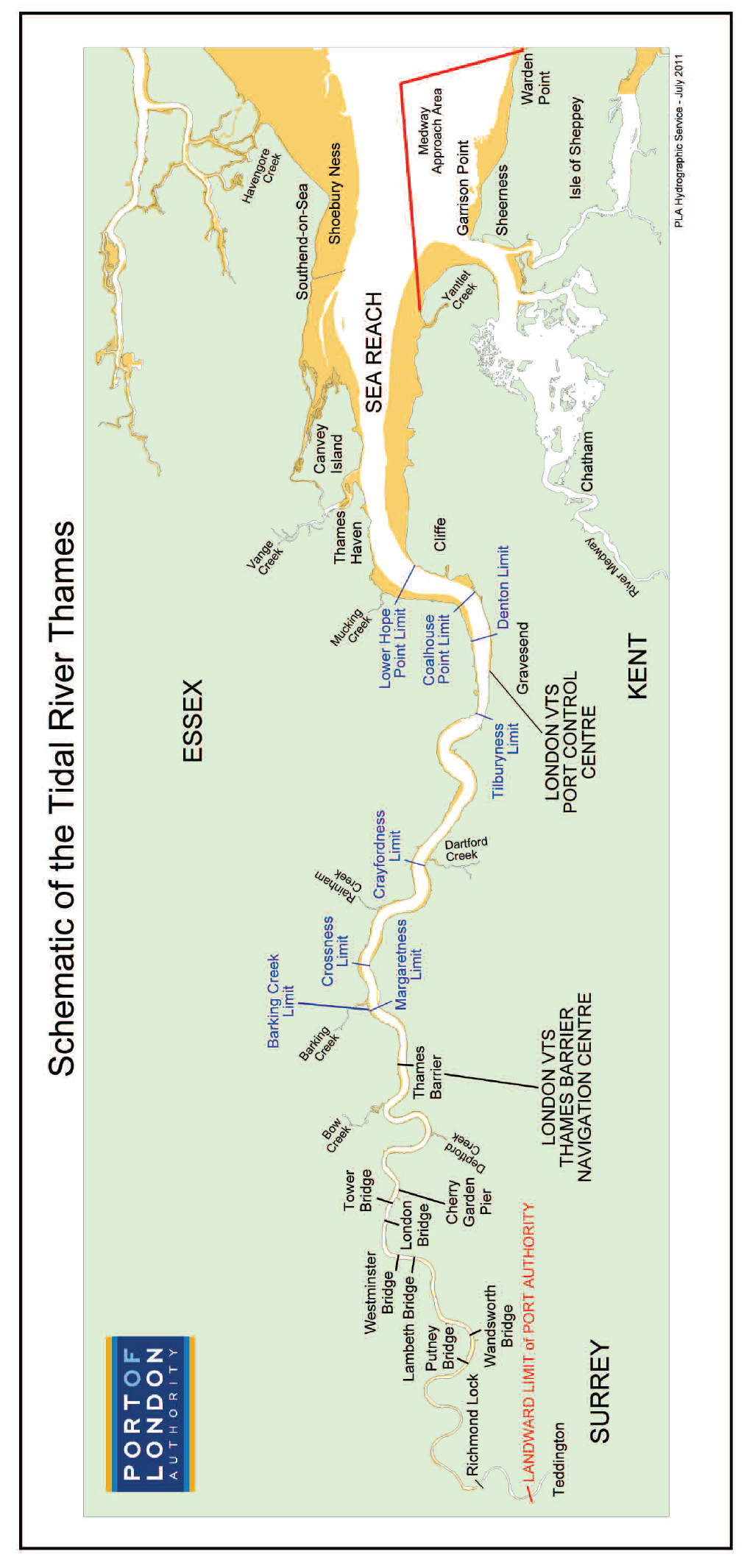
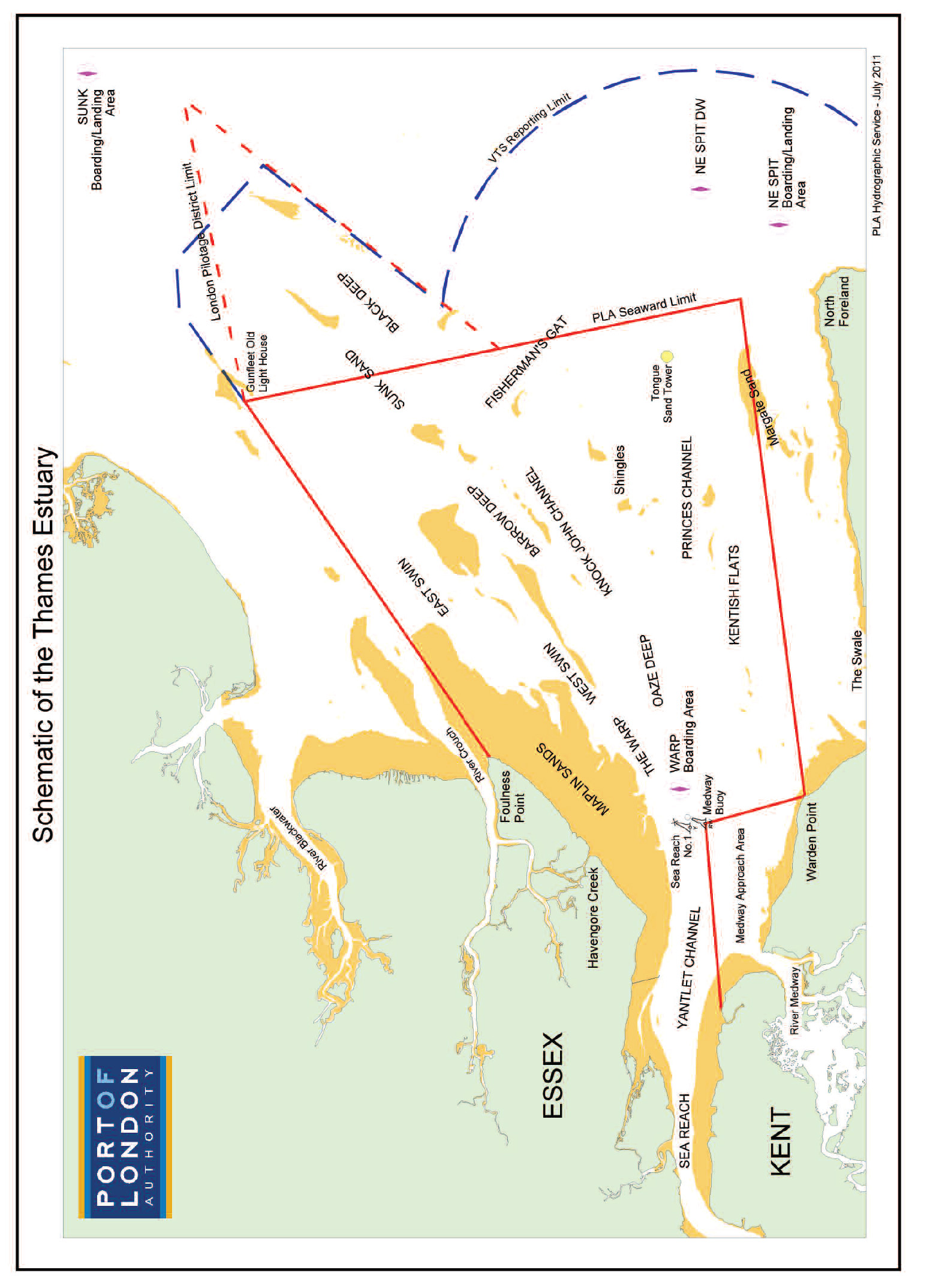
Appendix III
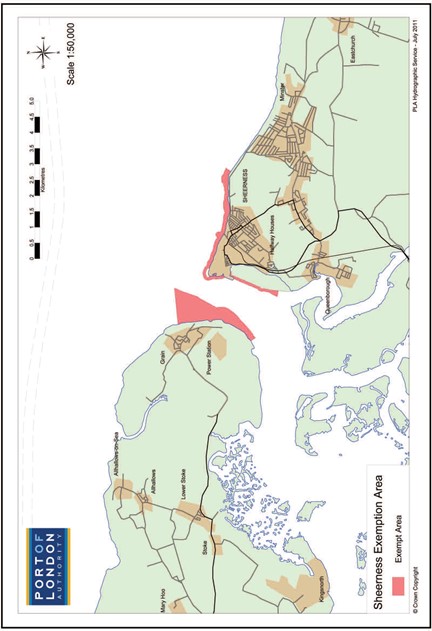

APPENDIX IV - LIGHTS AND SHAPES
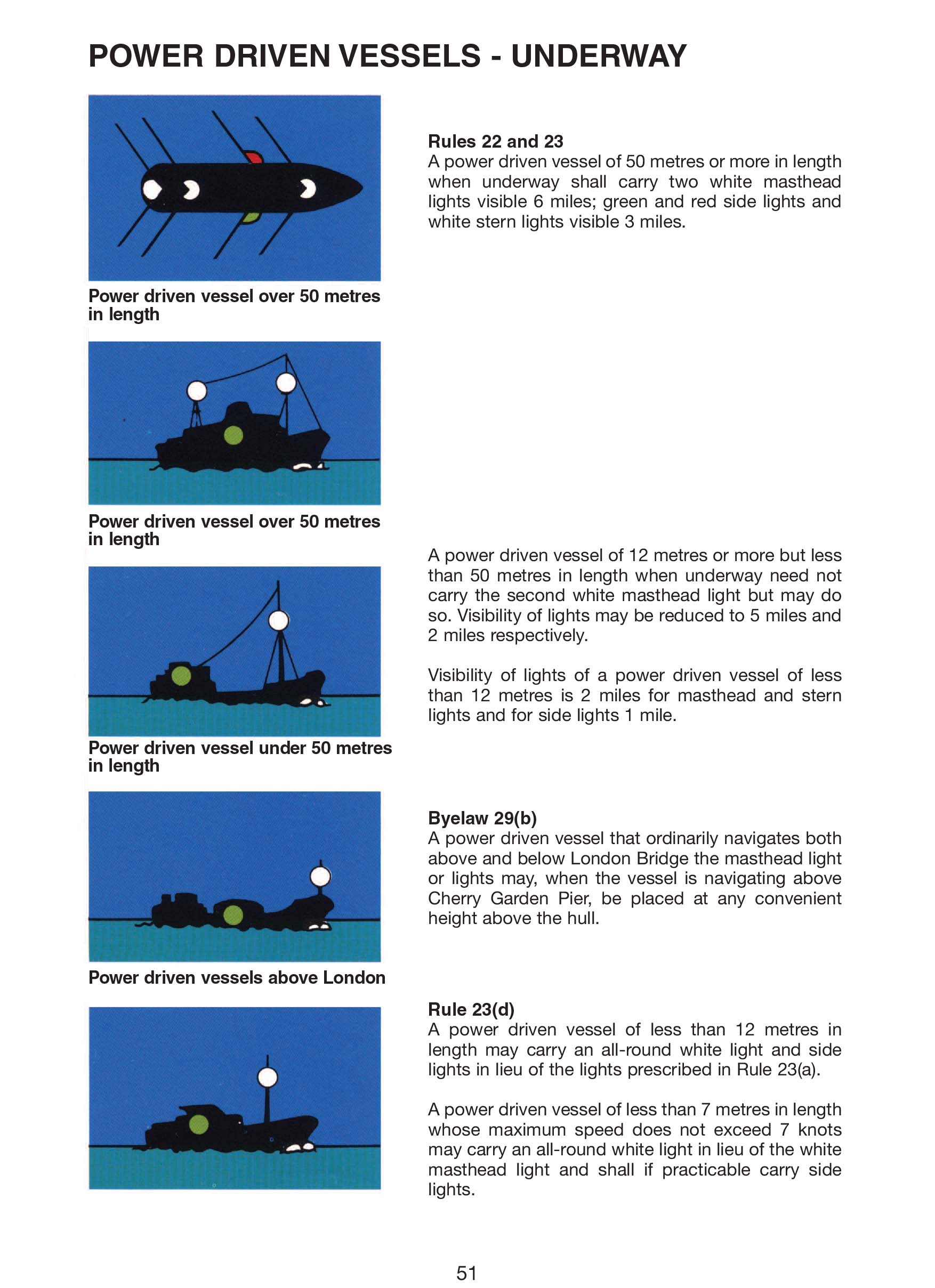
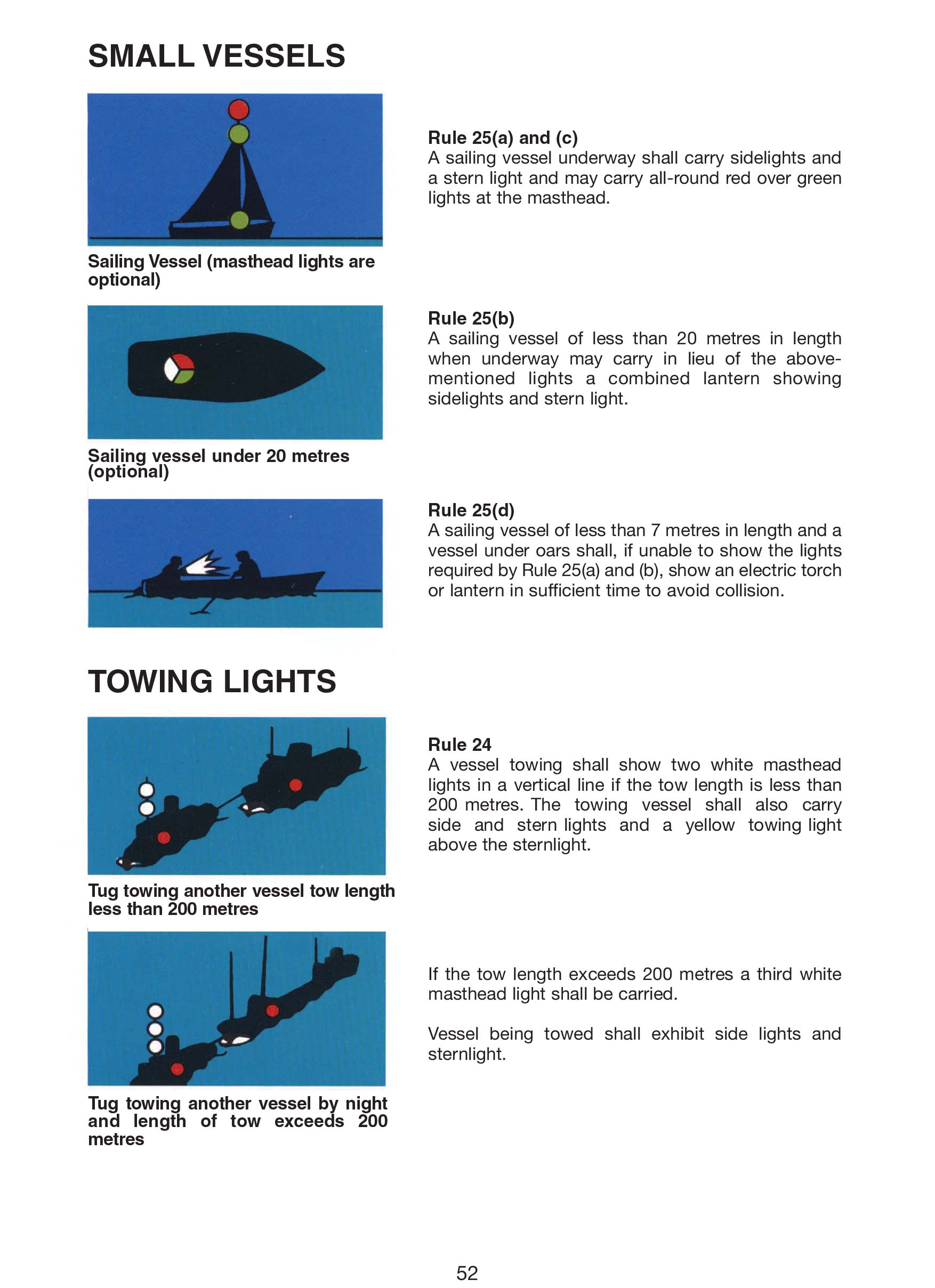

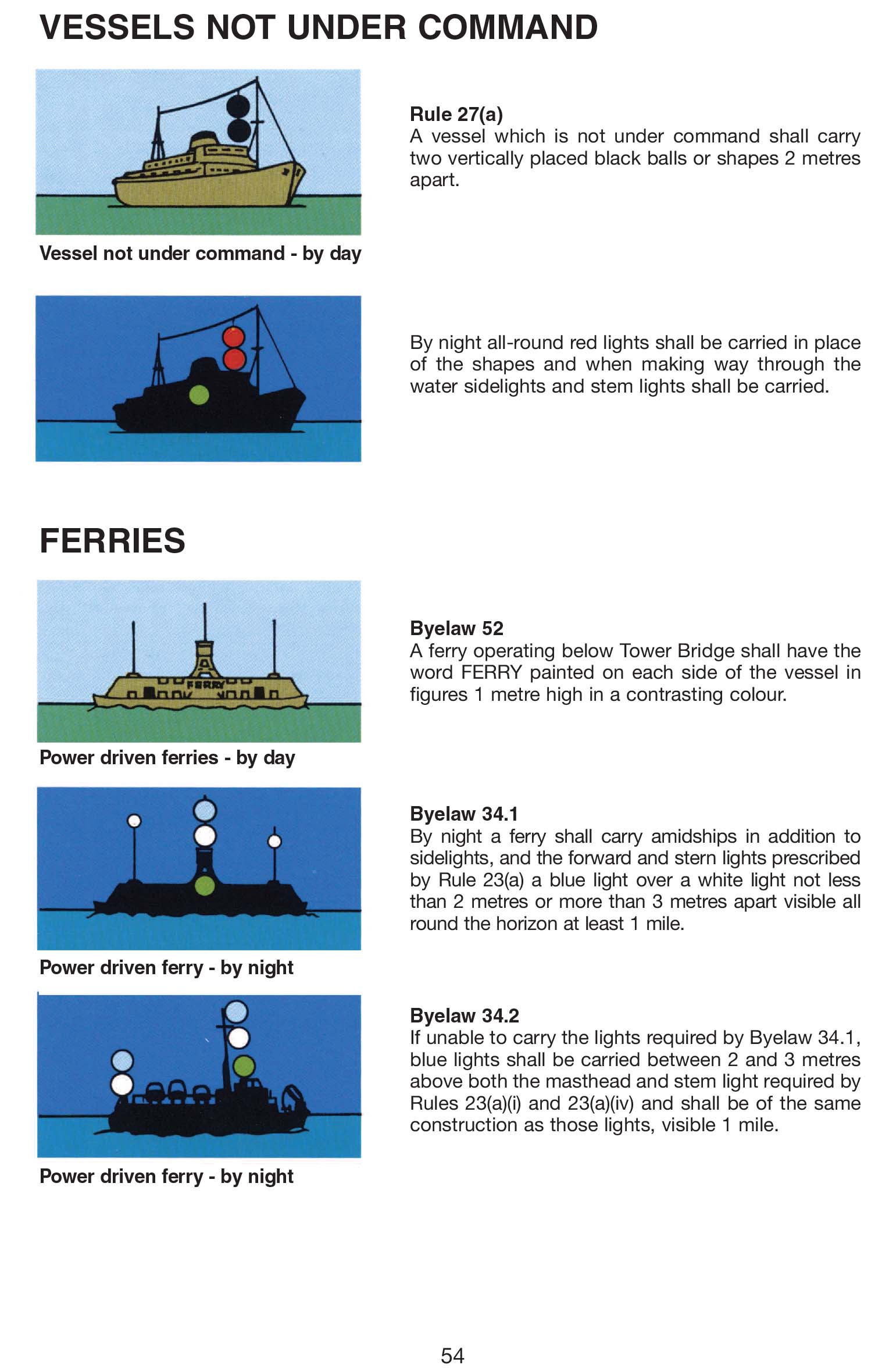
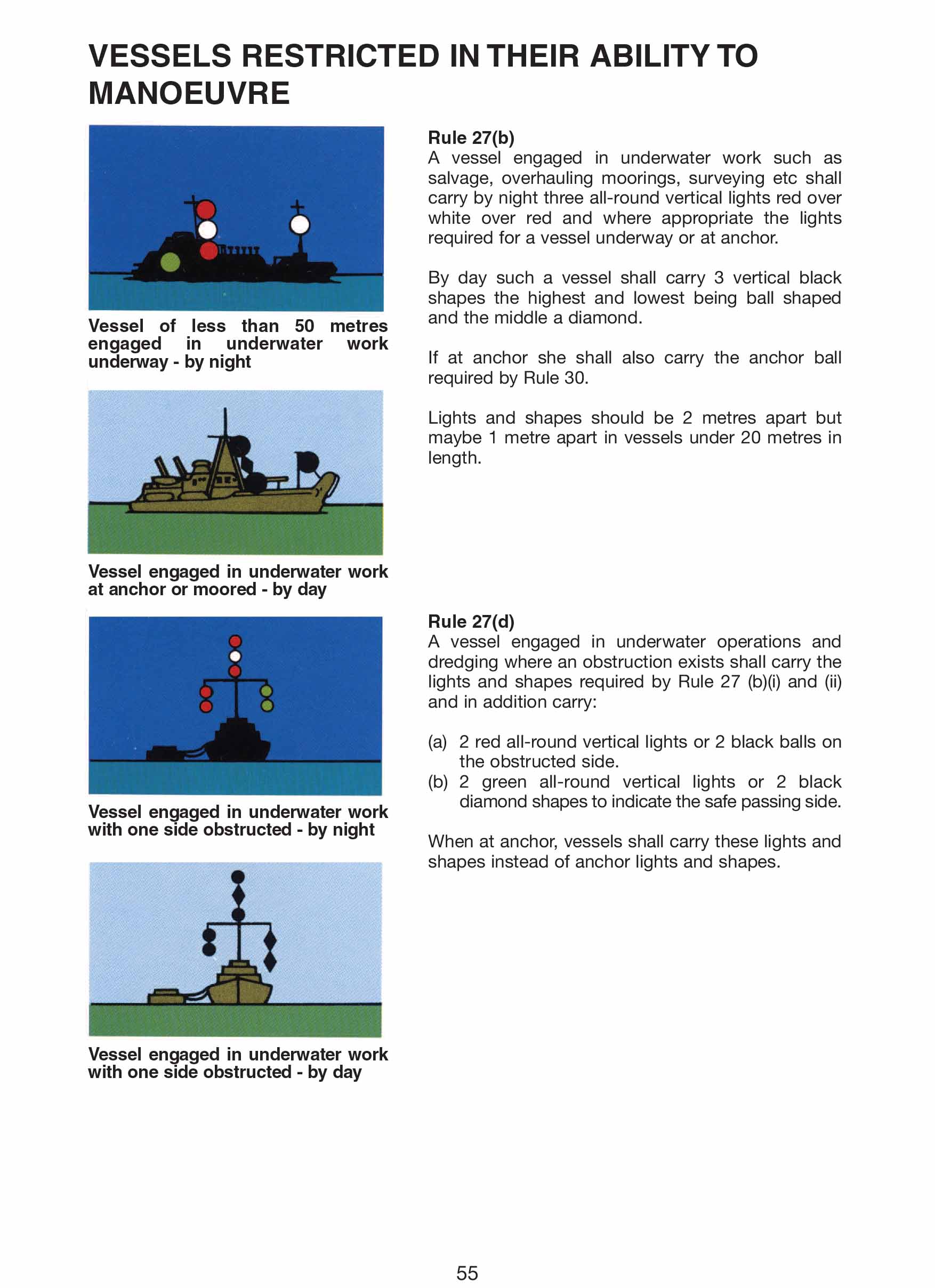
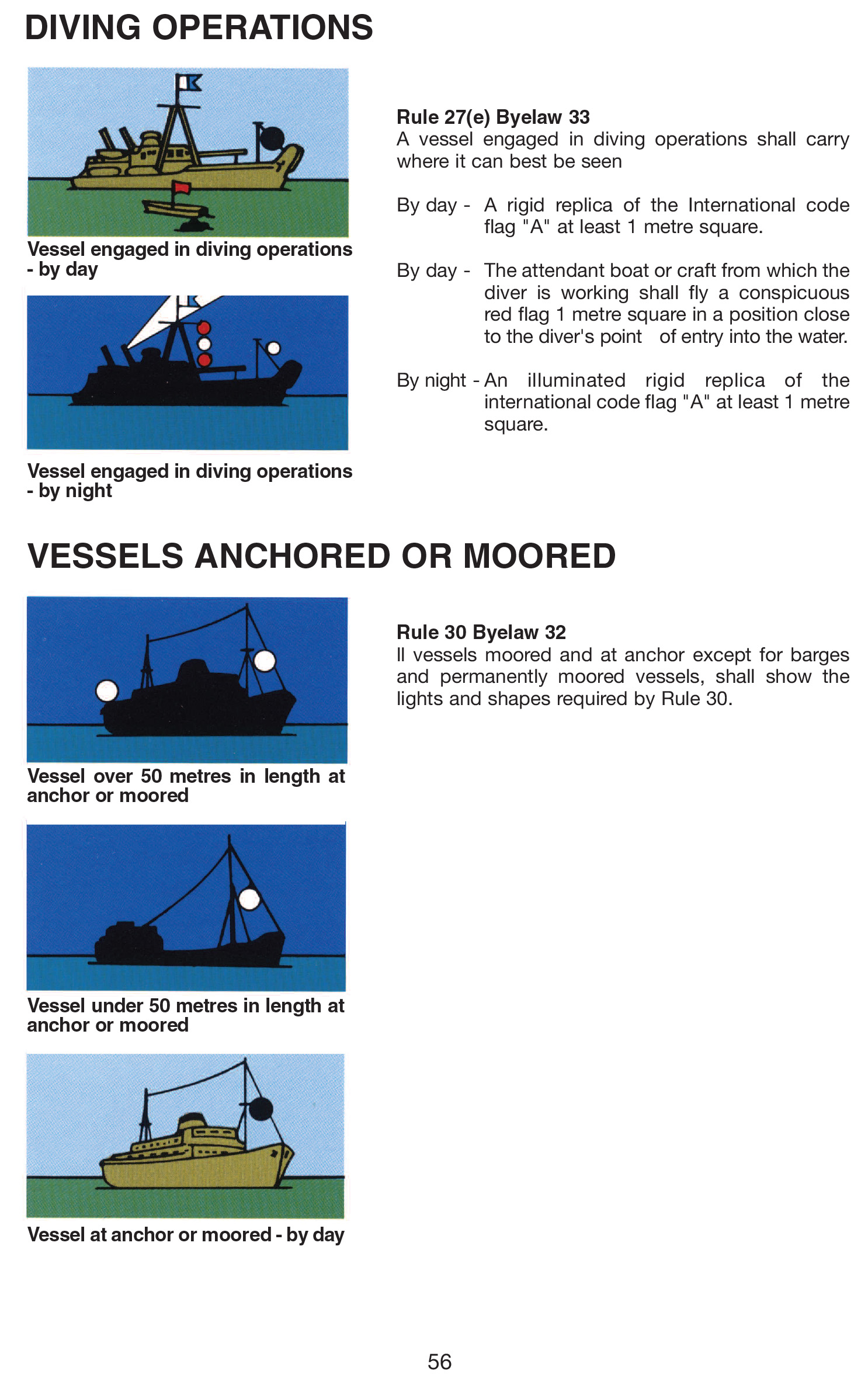
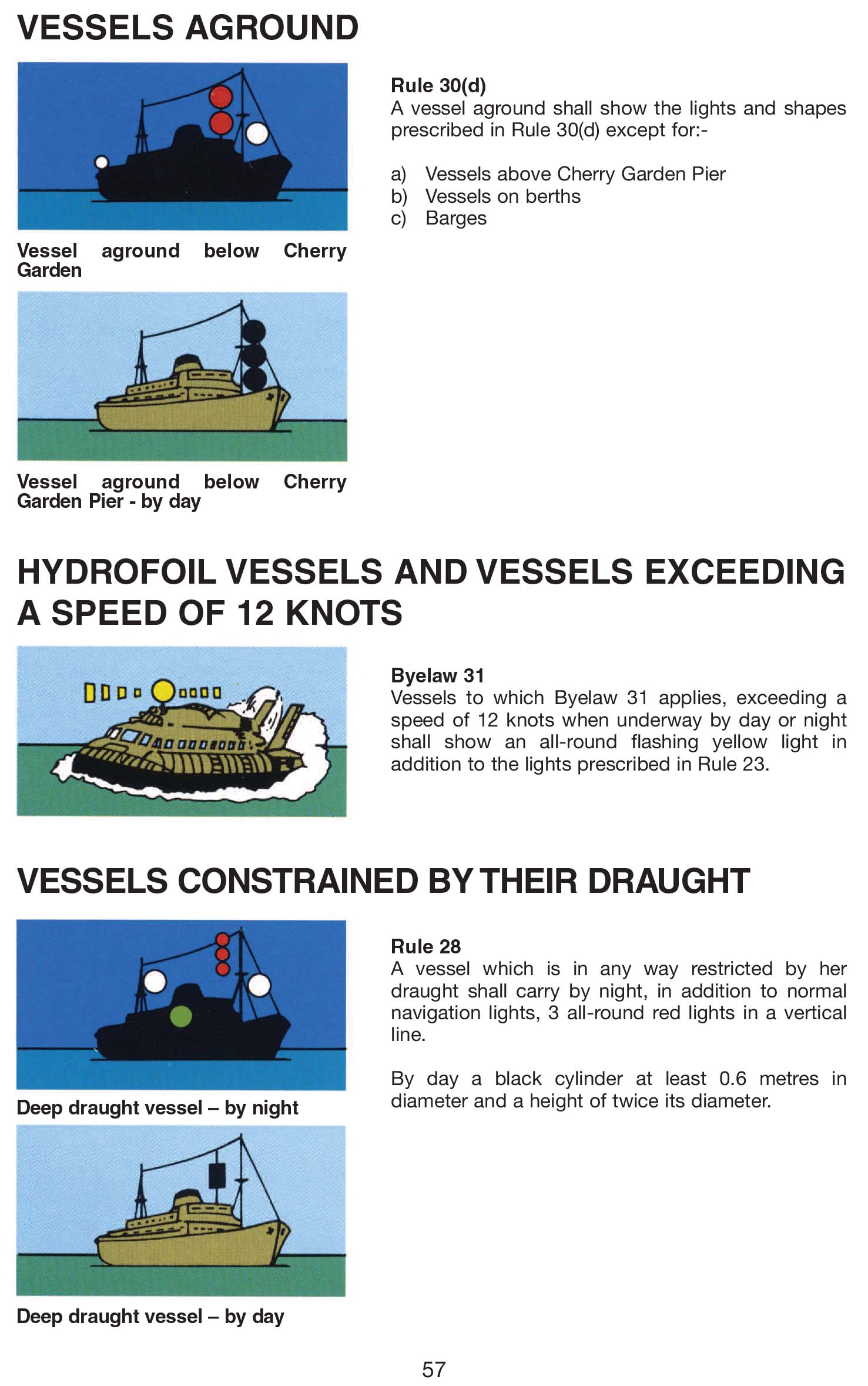

Filming, photography and events on the tidal Thames
A Director’s dream: 95 miles of the tidal Thames, one endless set, a thousand locations
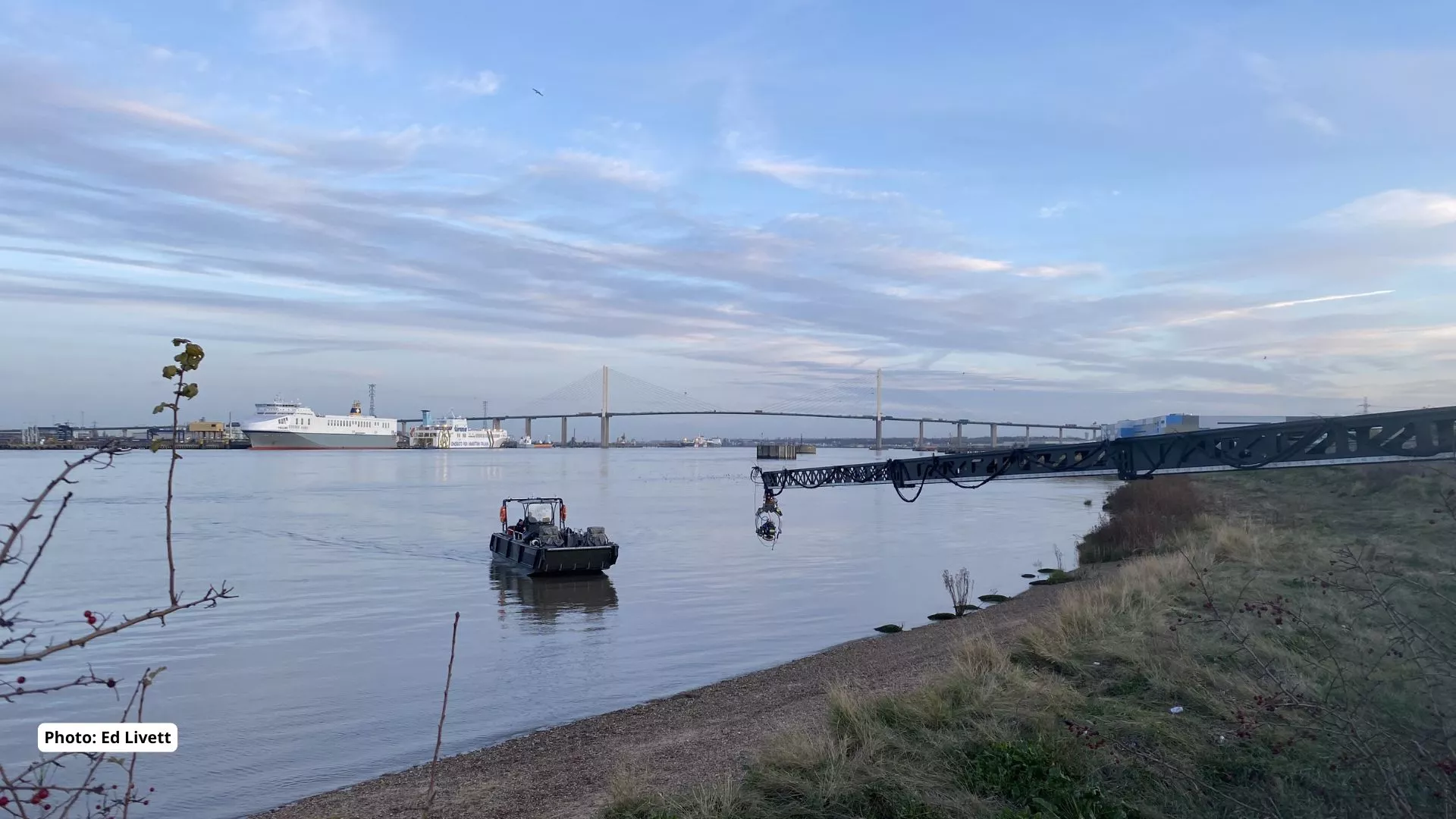
The tidal Thames stretches 95 miles from the North Sea, through central London, to Teddington, offering an exceptional range of filming and event locations.
We regularly support a wide range of activity, including major feature films, documentaries, advertising, commercials, and promotional events.
International crews are always welcome, and our team is here to help with permits, logistics, and filming safely on this busy working river.
A permit is required for all commercial filming, photography, and event activity on the tidal Thames.
A permit is required for activities including:
- Filming on or from vessels moored on and travelling on the Thames
- Filming or photography on or over the foreshore
- Use of piers, pontoons, jetties, or other river structures
- Promotional events or PR stunts on or over the river or foreshore
- Drone operations taking off or landing from the foreshore or a licensed vessel
This is because the tidal Thames is a working river and the safety of navigation, and all river users is our key concern. It is our statutory responsibility to keep river traffic moving. Our Harbour Master team considers river traffic management, safety considerations, and how best to coordinate complex or large-scale shoots and events.
Fees are agreed with our Corporate Affairs team and reflect the scale, duration, and complexity of your activity.
To apply for a film or photography permit, please complete this form.
If you need guidance, please contact us directly ([email protected]) or visit our FAQs.
Filming & Photography
A Director’s dream: 95 miles of the tidal Thames, one endless set, a thousand locations.
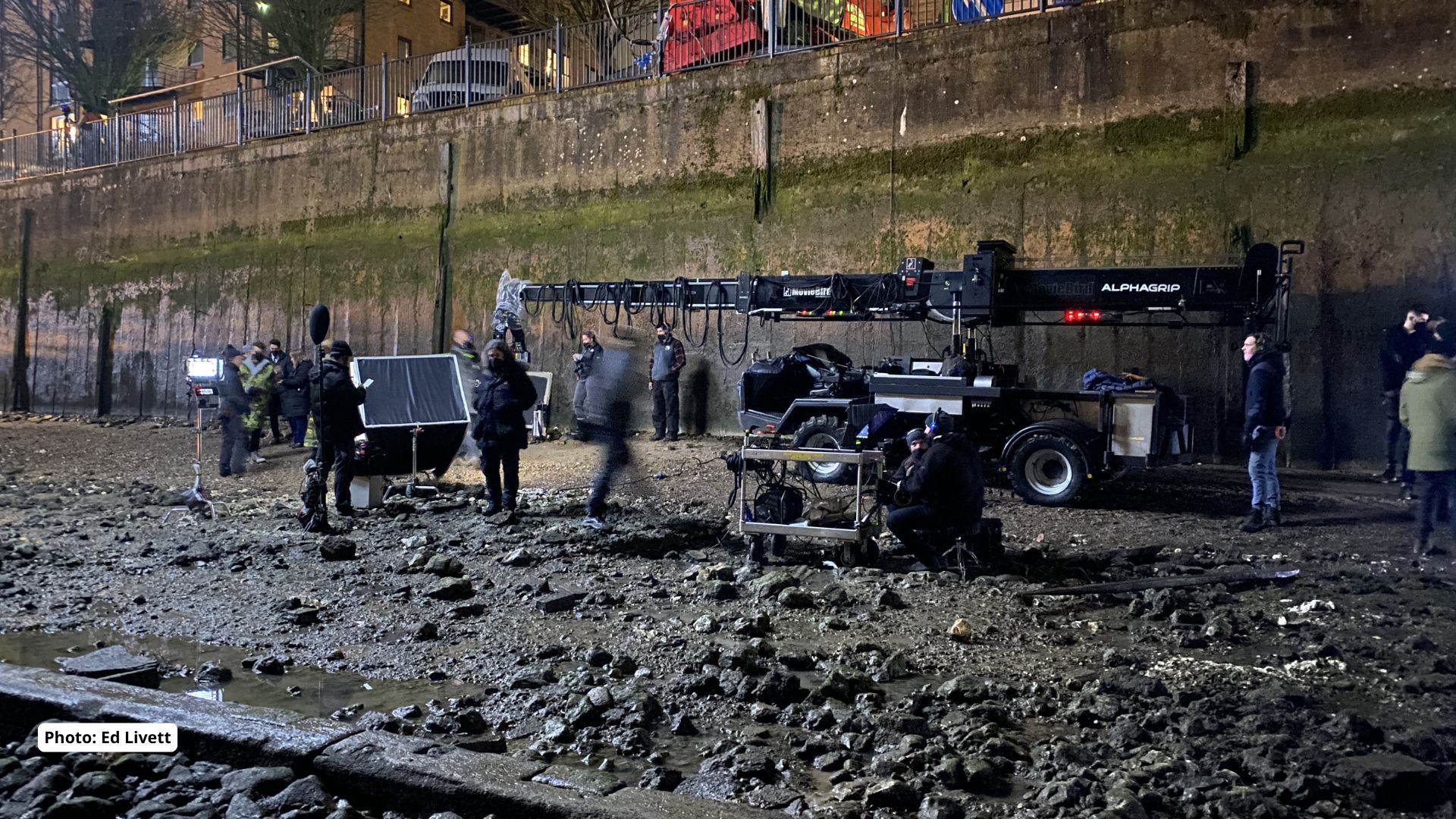
Promotional events
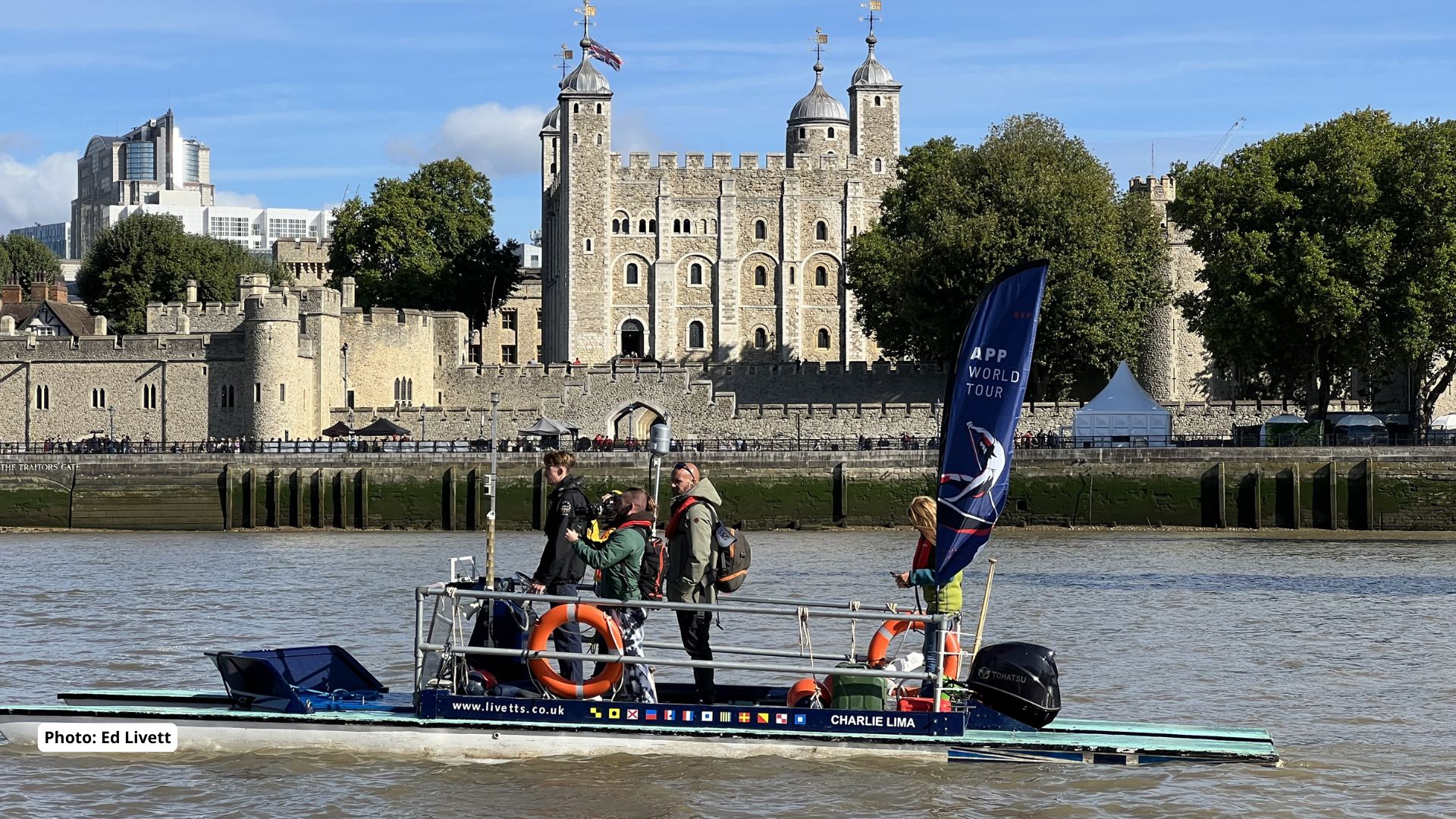
All events on the tidal Thames and its foreshore must be risk assessed and approved by the PLA Harbour Master team in advance.
Promotional events, brand activations, PR events and stunts are all considered on a case by case basis.
Please note these differ from river events, such as rowing races.
ALL fees for promotional events are by negotiation only.
Drone filming
Planning to fly a drone to film/photograph over the Thames or its foreshore for any commercial purpose?
If you're filming with a drone from a vessel or the foreshore for any commercial purposes, you need to complete a PLA film Permit form and a Drone Application.
To apply, you’ll need details including: an exact location (preferably What3Words), CAA Licence, risk assessment, flight plan, and drone specs.
Fees vary depending on the size, length, and complexity of your shoot.
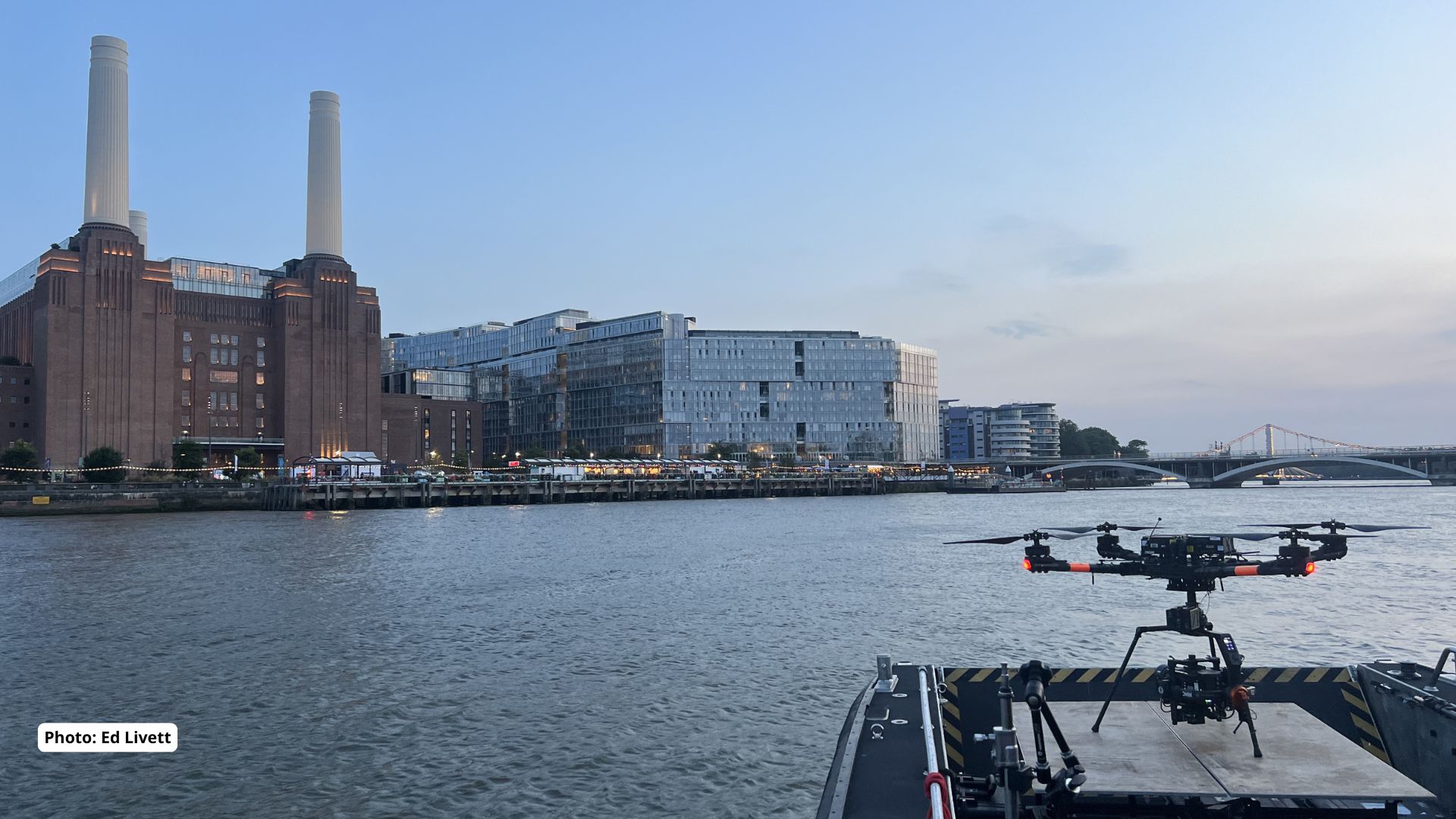
Managing river traffic
Filming on the foreshore
For large-scale shoots or events that could impact navigation, the PLA may need to:
- Issue a Notice to Mariners
- Dispatch Harbour Service launch vessels
These services carry additional costs and must be arranged in advance. The costs of both these activities must be paid in full by the film maker/event producer.
The Thames foreshore is hazardous and can become dangerous quickly due to fast tides, slippery access, and hidden risks like sewage, sharp objects, and potential disease.
All access is at your own risk, so please take precautions, and check tide times before planning your project or event.
Frequently Asked Questions (FAQs)
Yes. Any filming activity on the foreshore or from a vessel the tidal Thames generally requires permission from the Port of London Authority (PLA) in the form of a filming permit. This includes commercial shoots, editorial shoots, feature films & TV productions, documentaries, online social media content, and drone usage.
Filming permits are issued by the PLA, however, you may also need permission from other stakeholders, such as local borough councils, the Environment Agency, or private landowners depending on your location and activities.
Tidal Thames: Managed by the PLA (from Teddington Lock to the North Sea).
Non-tidal Thames: Above Teddington Lock, permissions may be required from the Environment Agency or riparian landowners.
Bridges, piers, and towpaths often require separate permissions.
Yes. Permit fees vary depending on: The size and scope of the production location and duration, impact on river traffic or public access, fee structures can be provided upon enquiry or after a preliminary assessment.
Applications submitted out of the five working day notice period will incur a late fee.
Yes, but drone filming requires not only permission from the PLA, but permission from the Civil Aviation Authority (CAA) and possibly local authorities as well as proof of pilot qualifications and insurance.
For small productions, please allow at least five working days. For more complex productions and events, please allow a minimum of four weeks.
The Harbour Master Team need adequate time to assess the potential navigational safety risks as the tidal Thames is a working river.
No, scuba diving is NOT permitted on the tidal Thames on any occasion.
Surface diving is allowed in circumstances, pending a permit approval which can be applied for here.
Please clearly state you will be diving in your application so it can be flagged for early consideration.
Yes. Filming involving; pyrotechnics or special effects, drone operations, river closures or major disruption and diving or stunts will require additional scrutiny and safety assessments. Please make sure to include this in your application and submit your risk assessment as early as possible to ensure we can accommodate your requests.
No, we cannot close the river, however, we can restrict access for short periods of time, but this requires significant planning. There are additional Harbour Master fees for traffic freezes and stakeholder consultations. Safety is our key priority at the PLA, and some productions may not be possible, even with extra precautions.
Traffic freezes aren’t allowed for continuity purposes but only to facilitate navigational safety.
Yes, but you must: use appropriately licensed and insured vessels, submit a risk assessment complying with PLA navigation rules, and highlighting crew and cast safety at all times.
Guides for event organisers
Essential information if your organisation is planning events on the tidal Thames or the foreshore.
Detailed information from our Harbour Masters on criteria that every event must meet before it will be permitted.
Key information on protecting the tidal Thames and its wildlife during your event.
Information organisers should consider to keep attendees safe when holding gatherings near the Thames.
Events taking place on the tidal Thames and its foreshore must have a permit from the Port of London Authority.
Event organiser guide
Events on the tidal Thames and its foreshore require the consent of the Port of London Authority
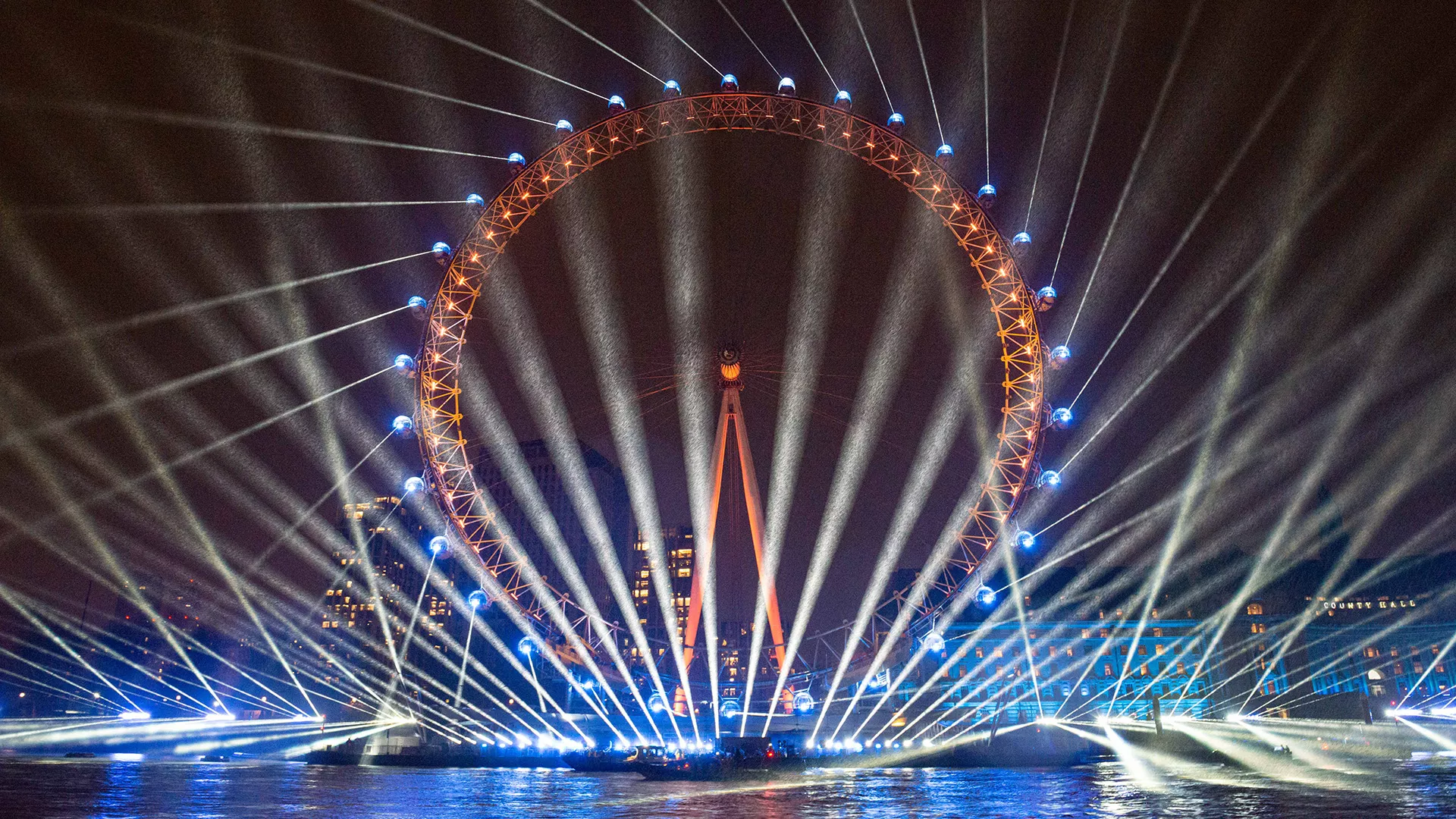
The Port of London Authority has the primary responsibly to maintain safe access and to manage and support the safety of navigation for all vessels using the tidal River Thames.
Thames Byelaw 9 requires event organisers to seek consent from the Harbour Masters should they want to organise a: recreational, sporting, race, sponsored event, display, regatta, rally, demonstration, culture event, a fireworks display or any other river event on the tidal River Thames. They should also consult with the Harbour Masters at least 4 weeks in advance of the proposed date.
The PLA requests that all event organisers consult with the Harbour Masters at their earliest opportunity, prior to undertaking any detailed planning for a proposed event or waterborne activity.
Harbour Masters: [email protected] or 01474 562 203 / 01474 562 328
Event organisers and persons involved in the proposed events/activity must comply with the provision of: the Port of London Act 1968; the Port of London Thames Byelaws 2012; the PLA General Directions for Navigation; Notices to Mariners and any other statutory requirements. They must also comply with instructions from PLA officers and their authorised representatives.
All events will be required to submit a formal Risk Assessment and event plan (including; numbers involved, timetable for event, location(s) of proposed event) for the proposed event/activity to the District Harbour Master. Should the PLA have any comments on these documents then these must be fully considered prior to the event being given consent.
Any non-rowing or non-sailing event taking place within or near an SSSI will need to be referred to the Environment team for review. In such case, organisers should consult with the Harbour Masters at least 6 weeks in advance of the proposed date.
It cannot be overstated enough, that early dialogue takes place with the District Harbour Master to ensure that it is clear what details will be required within the Risk Assessment and event plans. However in most cases the following as a minimum must be considered and include:
- Collisions (with fellow competitors and other Port users),
- Contact (i.e. piers, buoys, moored vessels, etc),
- Grounding
- Mechanical breakdown/failure
- Failure of safety cover
- Man Over Board (MOB)
- Weather considerations (with actual parameters as to when the event/activity will be abandoned or cancelled (this needs to include; wind speed/direction, temperature, restricted visibility, CSO status, ebb tide flag status),
- Abandonment protocols in case of incident, emergency or unsuitable conditions
- Evidence of insurance cover* (see note at bottom of the page)
- Environmental impacts on the river, river species and designated habitats sites.
- Minimisation of litter and use of sustainable materials.
- Consideration for the need for safety cover and appropriate checks carried out on Safety Boat(s) suitability.
The organiser must implement all safety recommendations arising from the Risk Assessment, and all requests by the Harbour Master.
The organiser must ensure that dispensation from certain regulations during the event, such as for Byelaw 16, are confirmed and authorised by the harbourmaster in writing.
Lifejackets/Buoyance Aids - If the event wishes to allow participants not to wear lifejackets/buoyancy aids, it must be proven within your risk assessment that the risk to participants is as low as is reasonably practical, and to the satisfaction of the district Harbour Master.
Event organisers must be able to demonstrate how they have made all participants aware of their responsibility to themselves and others in the event and/or Port users’ with regards to their ability to take part safely in the conditions as they find them on the day.
All participants must have access to any safety instructions used as mitigation in the Risk Assessment in advance of the event.
Where vessels are used for the carriage of persons or goods, each vessel must be under the charge of a person duly qualified as required by PLA Byelaws.
Any vessels utilised for proposed events/activities; which are not “pleasure vessels” as defined under the Merchant Shipping (Survey and Certification) Regulations 1995; must provide the District Harbour Master with the vessel’s PLA Licence or MCA Certification.
After approval but before the event
The District Harbour Master will issue the Event Organiser with a PLA Letter of Consent (LoC) which must be signed and returned prior to the event taking place.
The Event Organiser must confirm the number of participants with the District Harbourmaster, at least one working day in advance of the event.
On the day of the event the organiser must ensure that the weather and river conditions are suitable and that adequate marshalling, safety and rescue craft, capable of communicating with other vessels and London VTS through the medium of International Maritime Mobile band VHF radio, are available and all other identified risk control measures are in place.
London VTS must be contacted either by VHF or telephone (as below) before the start of the event and after the event has finished:
- West of Crayfordness -- VHF Channel 14 or 02032 607 711
- Crayfordness to Sea Reach No. 4 -- VHF Channel 68 or 01474 562 215
- East of Sea Reach No.4 -- VHF Channel 69 or 01474 562 215
Additional costs
Any additional services provided by the PLA following discussions with the Event Organiser (e.g. Harbour Service Launch to conduct Local Traffic Control or a River Closure) will be subject to additional charges.
If the PLA decides that a Notice to Mariners needs to be promulgated to advise fellow Port users of the event, the full administration cost of a Notice will also be subject to additional charges.
Regularly held events
Where events are held on a regular basis, for example a weekly or monthly yacht race organised by a club, a generic Risk Assessment and Event Plan may be authorised by the District Harbour Master for a limited period not exceeding 12-months. The Risk Assessment and Event Plan must then undergo a formal review, prior to re-approval. In all cases clubs are requested to inform the District Harbour Master of all events during this period so that adequate information can be promulgated to fellow Port users.
Firework displays
Due to the hazardous nature of these events, regardless of who is responsible for the event’s organisation, it is the firework display operator who should forward a Fireworks Display Method Statement and Risk Assessment to the District Harbour Master. The fireworks display operator must agree to comply with the Code of Conduct for Fireworks Displays available here.
The PLA will not normally permit private firework displays within Central London (Lambeth to Greenwich). However each display will be judged on it own merits especially in regard to the effects it might have on other Port users and the river environment.
Other aspects to consider
All event organisers will need to consider the following aspects in their event planning process:
Group activities on the Thames foreshore: Anyone wishing to organise a group activity such as a walk or guided tour which does not involve any disturbance of the Thames foreshore must first apply for permission from our Estates department on [email protected].
If the group activity involves any disturbance of the foreshore, then each participant must also have their own individual Thames foreshore permit. In addition, the event organiser will also need permission from the Estates department.
Environmental issues: should the event have an impact on the tidal River Thames environment (proposals for Waterscreens, Confetti, Streamers, fireworks, etc), this should be given careful consideration and discussions may be required with the PLA’s Environment Team to minimise the impact on the river. Balloon and lantern releases are not permitted over the river.
If the event is likely to impact on a designated habitat site (SSSI, SPA, SAC, Ramsar) the applicant must obtain permission from Natural England (NE) before applying to the PLA and provide evidence of NE approval with their PLA application.
Corporate / PR / advertising / sponsored events: Should an event on the river be corporate / corporate sponsored and / or involve any commercial branding / logos / advertising or PR element then the activity should be discussed at an early stage with the PLA Corporate Affairs Team. (This includes any private / corporate fireworks). A commercial licence fee is charged for all such corporate activities including those with branding / PR / advertising etc.
Similarly, if the event involves any professional filming / video / photography, the vessel shall be suitably licensed for the carriage of passengers and you will need to apply for a filming licence from the PLA Corporate Affairs Team.
Consultation: The Event Organiser, where appropriate, needs to consult the following organisations (which is not an exhaustive list):
- HM Coastguard
- Local Emergency Services
- The Royal National Lifeboat Institute (RNLI)
- The Local Authority/Council
Further reading
- Event Organisers should be familiar with the Maritime & Coastguard Agency's Port Marine Safety Code and A Guide to Good Practice on Port Marine Operations.
- The Royal Yachting Association (RYA), British Rowing’s Thames Regional Rowing Council (TRRC) and British Canoeing have their own risk assessment guidelines and these are available on: https://www.rya.org.uk, https://www.thames-rrc.org and https://www.britishcanoeing.org.uk respectively.
* The PLA Event Letter of Consent has the following statement regarding insurance cover:
a. be responsible for all risks and liabilities directly arising out of or incidental to or connected with the organised event and shall keep the PLA its employees and agents fully indemnified from and against expenses, losses, damage, liability and claims only where and to the extend that the Organiser(s) are negligent and or are legally liable for
(i) personal injuries or death to any person (save where such injuries or death arise from the negligent actions of the PLA its employees or agents)
(ii) loss of or damage to any property (and the term “property” include the river bed and any property belonging to the PLA) (save where such loss of or damage to property arises from the negligent actions of the PLA its employees or agents)
(iii) any breach or non-observance of the covenants and conditions of this licence and any other loss, damage cost or expense (whether or not due to negligence) arising out of or in consequence of the carrying out of the agreed activities or the presence of the Organiser(s) their employees agents independent contractors or invitees on the river for the event;
(The PLA will give notice to the Organiser(s) of any relevant action, proceeding, claim or demand of which it becomes aware but the Organiser(s) shall not take over the conduct of any action or proceeding or defend settle negotiate compromise or otherwise deal with any claim or demand made to or involving the PLA and covered by the above indemnity without first obtaining the PLA’s consent (not to be unreasonably withheld or delayed.)
b. not make any claim against the PLA nor its employees or agents for death or personal injury, or other loss or damage including any damage to property (unless caused by the negligence of the PLA or its employees or agents) arising out of or in consequence of the carrying out of the agreed activities or the presence of the Organiser(s) their employees agents independent contractors or invitees on the river for the event;
c. without prejudice to its liability to indemnify the PLA the Organiser(s) shall maintain with reputable insurers such insurances as may be necessary to cover the death of or personal injury to any person and loss or damage to any property and any claim which may arise under the provisions of sub-clause a. above out of or in consequence of the carrying out of the agreed activities or the presence of the Organiser(s) their employees agents independent contractors or invitees on the river for the event and such insurance shall provide cover of not less than five million pounds (£5,000,000) for any one incident the number of incidents to be unlimited. The Organiser(s) shall prior to the start of the event supply to the PLA a copy of the relevant insurance policy or policies.
d. ensure the event and participants in the event cause no harm to the tidal Thames environment and its wildlife.
Guides for event organisers
Essential information if your organisation is planning events on the tidal Thames or the foreshore.
Detailed information from our Harbour Masters on criteria that every event must meet before it will be permitted.
Key information on protecting the tidal Thames and its wildlife during your event.
Information organisers should consider to keep attendees safe when holding gatherings near the Thames.
Events taking place on the tidal Thames and its foreshore must have a permit from the Port of London Authority.
Environmental guidance for events
Advice on reducing the environmental impact of events on or near the river
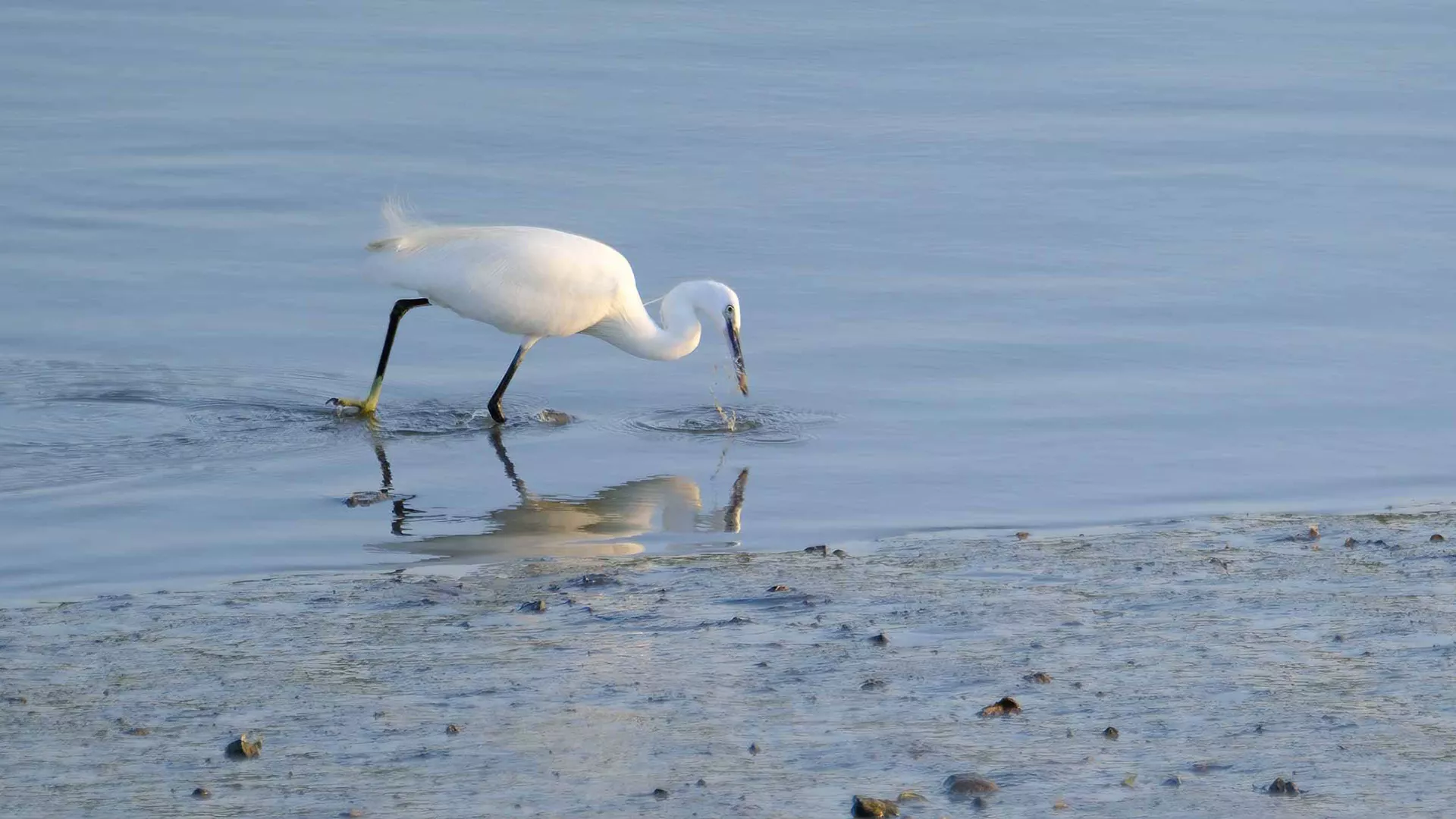
The Port of London Authority has a duty to protect and conserve the River Thames. Under the PLA's environment policy there is a commitment to reduce pollution and waste in the river and the Ports business. We recognise that event organisers also want to minimise their impact on the river and the PLA has provided this guidance to assist them.
Legislation
All events within the river must comply with the Port of London Act 1968 and the Water Resources Act 1991, section 85, which
regulates any polluting matter entering controlled waters. The Water Framework Directive (2000/60/EC) asks for protecting and improving the water environment. All events should be undertaken inline with the PLA’s Environmental Policy. Environment Agency guidance to the Port of London Authority states there should be no lasting effect, either short or long term to the marine environment. These elements are all considered in the following guidance.
Confetti, streamers or leaflet drops
Due to their lasting effect, these will not be given permission. Even in small quantities there is a lasting effect. Depending on the weather and river conditions the pieces can spread far across the surface of the water and can be deposited on the foreshore in the strandline for some time after the event.
Some types of biodegradable and water soluble papers or petals have also been considered, but can not be permitted. Metallic confetti used in pyrotechnics will last for much longer periods of time and may sink, reducing the chance of it being removed.
Material in the water will degrade and this process takes oxygen from the river. While the process is occurring the materials will persist in the water and cause increased litter in the river, and on the foreshore. Scavenging birds and animals may mistake them for food during this time. Vessels in the area may also have problems with paper or PVA products collecting in their intakes immediately after the event.
Altered water/painting projects
If it is possible the colour in a cascaded waterfall/hydrant should not be visible once it hits the Thames. Painting projects should be kept away from the Thames, for example be on a floating, bunded structure that contains all falling paint from the public activity of painting. The structure must be removed and cleaned elsewhere.
Additives and paints can be damaging to aquatic organisms and the environment and all additives must be approved by the Environment Agency in writing before the PLA will consider the event.
Event organisers should consider the need to have the activity on the river or use of river water for the potential human health implications. (http://www.rospa.com/leisuresafety/adviceandinformation/watersafety/weils-disease.aspx)
Balloons and lanterns
A large amount of balloons over the Thames will also cause a lasting effect. They can last for days on the water surface, often causing the emergency services to be called to them having been mistaken for persons in the water.
They can also tangle around birds legs. Despite being sold as biodegradable the latex balloons can take months or years to degrade in the marine environment. Once burst they can be ingested by marine birds and mammals, causing them to starve. The PLA does not recommend the use of balloons during events along the banks and would not approve large intentional releases from a structures over or vessels on the Thames.
Over a period of five years, the Marine Conservation Society found on average 3 balloons per 100 metres during their Great British Beach Clean.
Sky and floating lanterns also pose similar threats to wildlife and navigational safety. They appear similar to red flare and have caused several false alarms for search and rescue services. They can cause confusion when floating on or near to the surface of the water, as they can be mistaken for another vessels lights.
They can cause significant damage to property due to their high heat and flammable contents.
The component parts become a hazard to the environment with entanglement from the frames, or ingestion of the frame. The PLA does not approve releases of floating or sky lanterns from structures over or vessels on the Thames.
Find out more: https://www.mcsuk.org/what-you-can-do/ocean-friendly-living/dontletgo/
Rubbish collection and control
All events are likely to encourage more people to the river or its banks. This will increase the amount of rubbish that is created. Event organisers need to consider provision of waste management, prevent it entering the river, and recycle as much as possible.
Vessel use
All vessels used in the event should comply with the PLA and/or MCA licencing requirements, and should be fueled responsibly, in accordance with the PLA byelaws.
It is recommended that all support vessels carry a spill kit in case of an emergency during the event. Guidance on the appropriate contents can be found at http://www.thegreenblue.org.uk/leaflets__resources.aspx
Vessels coming from areas outside of port limits may be creating pathways for alien species not yet in the tidal Thames. Guidance should be sought from the PLA and the Environment Agency on the precautions that may need to take place prior to entering the port limits.
Find out more: https://thegreenblue.org.uk/advice/
The Green Blue
The Green Blue is a joint environment programme created by the British Marine Federation and the Royal Yachting Association for anyone who enjoys getting out on the water or whose livelihood depends on it. Guidance has been created to help event managers reduce their impact on coastal and inland waters. https://thegreenblue.org.uk/marine-businesses/
World Rowing
World rowing provides guidance on how to minimise the impact on the environment of rowing events. https://worldrowing.com/responsibility/sustainability/
Additional advice
If you require any further advice or guidance please contact the PLA’s Environment Team on: [email protected]
Guides for event organisers
Essential information if your organisation is planning events on the tidal Thames or the foreshore.
Detailed information from our Harbour Masters on criteria that every event must meet before it will be permitted.
Key information on protecting the tidal Thames and its wildlife during your event.
Information organisers should consider to keep attendees safe when holding gatherings near the Thames.
Events taking place on the tidal Thames and its foreshore must have a permit from the Port of London Authority.
PLA awards pilot vessel contract to family-owned British boat builder
Following a competitive, international selection process, the Port of London Authority (PLA) has signed a contract with Goodchild Marine Services Ltd, to build a new pilot vessel.
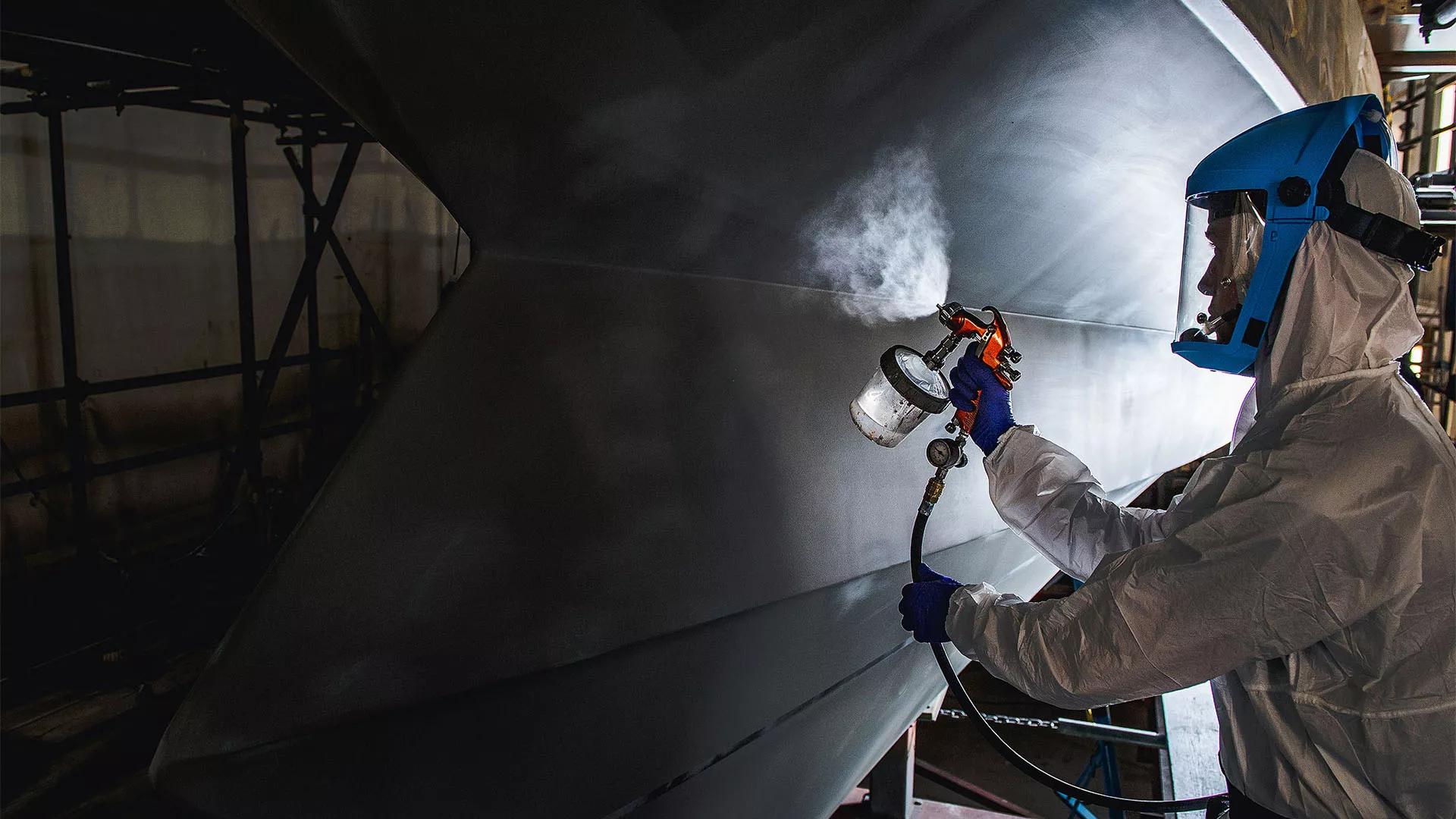
Headlines
- Goodchild Marine is a family-run and British-owned company
- New vessel is part of our largest capital investment plan in over 20 years
- Will help us meet our Thames Vision commitment to be the UK's leading Net Zero port by 2040
With 95 miles of the tidal Thames under its jurisdiction, the PLA, the UK’s largest port, is investing significantly in its people, infrastructure and equipment to meet increasing demand for its pilotage services as its customers and terminals continue to grow.
“Goodchild has proven over many years that they are at the leading edge of vessel design and build. This new vessel is designed specifically for our current and future operational needs, and will incorporate the latest in technology, reducing fuel consumption, minimising environmental impacts, whilst maximising operability."
This winning tender follows Goodchild Marine’s success during London International Shipping Week, where it was honoured twice at the 2023 National Maritime SME Awards, collecting the awards for “Best Family Business” and overall winner of the “National Maritime SME Business of the Year”.
PLA’s Director of Marine Operations Steven Clapperton, said:
“Goodchild has proven over many years that they are at the leading edge of vessel design and build. This new vessel is designed specifically for our current and future operational needs, and will incorporate the latest in technology, reducing fuel consumption, minimising environmental impacts, whilst maximising operability. Having previously built pilot vessels for both the PLA and its subsidiary company, Estuary Services Limited, utilising a proven, modern, energy-efficient hull form, Goodchild Marine will customise the new PLA vessel to include additional accommodation and extra seating, maximising passenger capacity to support the PLA’s extensive pilot training programme, to sustain the continued and forecast growth in the port.”
Goodchild’s General Manager Stephen Pierce, said:
“As a family run company, it is a privilege to continue our working relationship with the Port of London Authority. This contract affords us the opportunity to continue to develop our range of pilot boats to meet the operational requirements of UK ports both small and large.”
This vessel acquisition represents a small part of the largest capital investment plan for the PLA in over 20 years. Supporting our customers’ future growth plans, this investment plan is key to delivering the PLA’s Thames Vision; to be the UK’s leading Net Zero port by 2040.
Related content

Location: London/Gravesend Remuneration: £28,971 per annum for a commitment of up to 24 days per...
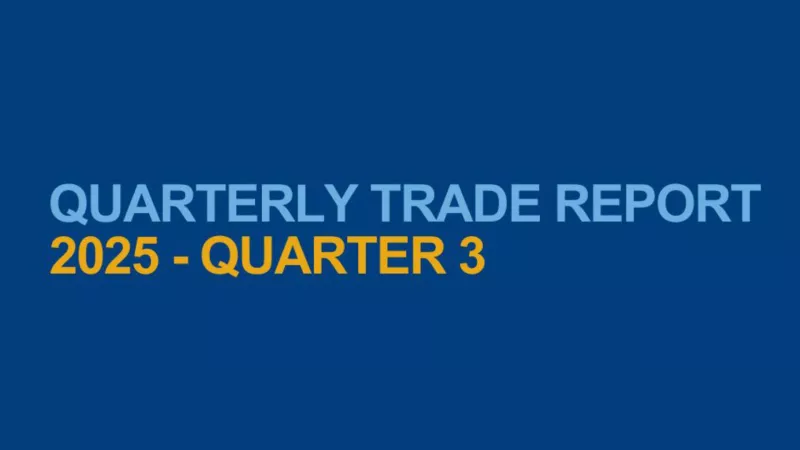
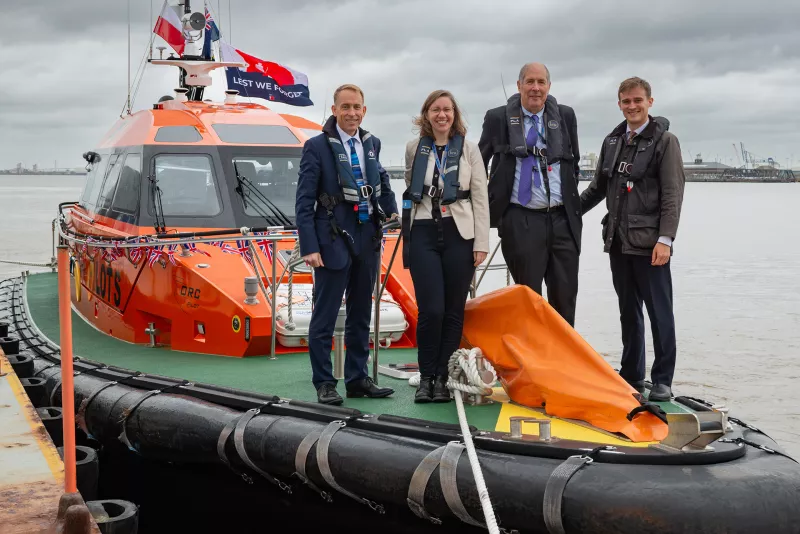
Discover
